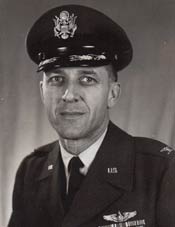|
Benton R. Baldwin was born December 11, 1908 at DeLand, FL. He died May 20, 1995 at age 86 at Winter Park, FL. He flew for United Airlines and in the military rose to the rank of Colonel.
R.B. Baldwin, February 8, 1931 (Source: Baldwin Family)
 |
The Benton Remmers "Lucky" Baldwin Photograph and Document Collection evolved as have many of the entities on this Web site. I first published on January 12, 2009 a biography of Baldwin, as I have done for hundreds of other Register pilots on dmairfield.org. Most of that information came from his NASM biographical file (cited, left sidebar).
An expansion of Baldwin's original Web page came when site visitor Paul Denault contacted me with news of many photos and documents in his possession that belonged originally to Baldwin. I added those items to Baldwin's page September 27, 2011. Shortly afterwards I was contacted by Baldwin's son, John, who offered to share even more of his father's photographs, documents and memorabilia. These items are exhibited below. At right, for example, Baldwin is 23 years old as he poses with a tennis racket in front of a Ford automobile that he used in college. The Ford is cited in the accounts book available at the link below. The caption he wrote on the back of the photograph says, "Me dressed for tennis with my Ford, Berkeley, Cal." The house is identified as 1815 Highland Place.
Even from all these sources, it is difficult to characterize Baldwin. The personal qualities and aptitudes he possessed served him well in his job and duties as a pilot of complex aircraft. He was mechanically inclined, studied engineering, was curious, persevered in projects (Eagle Scout) and was a stickler for details. This latter trait is manifest all through his life from an early accounts book in which he kept track of the smallest financial detail, to the meticulous recording of each of his flights in his flight logs, to his collections of rocks, coins and stamps. As well, he kept hundreds of personal letters from the 1920s through to the end of his life. Most are family or business correspondence; some were from many women he entertained successfully at various ports of call before during and after WWII.
The volume of items clearly justifies this Collection, which is presented to you with full permission from his family. They offer you 82 photographs and 35 PDF downloads to enjoy and to help us understand the life of this complex man. Please take some time to review his separate biography page at the link above to see an additional 45 photographs and letters and 3 downloads. Most of his personal letters are on that page.
The Collection is below, and at the hyperlinks therefrom. I choose to divide this page into six segments: his EARLY LIFE, and, even though they overlap significantly, his MILITARY CAREER, CIVIL CAREER and RETIREMENT. A highlight of Baldwin's Collection is a MOVIE produced by his son who edited his father's various 8mm and 16mm movie films saved from WWII. Also included are SIX PILOT LOG BOOKS kept by Baldwin for the years 1933-1942. These include two military logs and four United Airlines logs.
---o0o---
EARLY LIFE
This section consists of 29 photographs and documents and two downloads arranged more or less chronologically.
Baldwin was born December 11, 1908 at DeLand, FL. Below, his birth announcement telegraphed to his grandparents (of German extraction) in Pennsylvania.
Telegram Announcing Birth of Benton Baldwin, December 11, 1908 (Source: Baldwin Family)
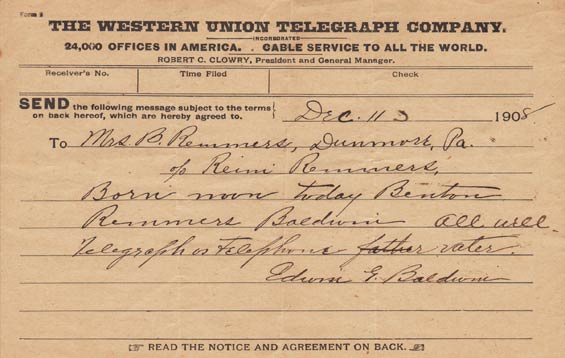 |
Below, courtesy of his family, are two portraits of him when he was one year and four years old. In the right-hand photo, he is with his younger sister Berta.
Benton Baldwin, One Year Old (Source: Baldwin Family)
 |
Benton Baldwin (R), Four Years Old (Source: Baldwin Family)
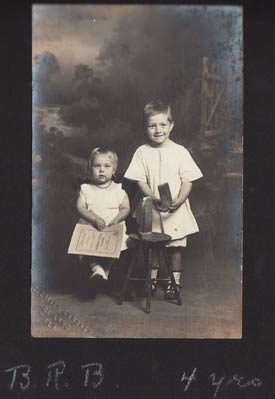 |
We have two of Baldwin's elementary school report cards for first and second grade in the Volusia County, FL public school system. In the first grade during 1914-15, Baldwin was an excellent student with only an eary inclination to mischief. After his first marking period, he seemed to knuckle down and improve his deportment. The second grade was more of the same. Below are those two-page report cards with first and second grade showing from top to bottom.
B.R. Baldwin, Report Cards, 1914-16 (Source: Baldwin Family)
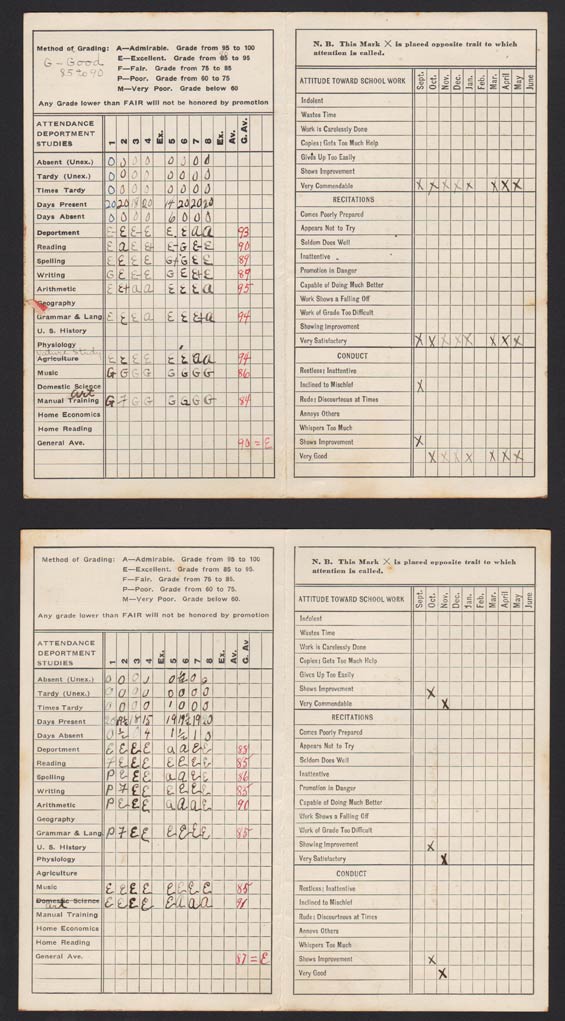 |
Below, the outside of the cards with parental signatures.
B.R. Baldwin, Report Cards, 1914-16 (Source: Baldwin Family)
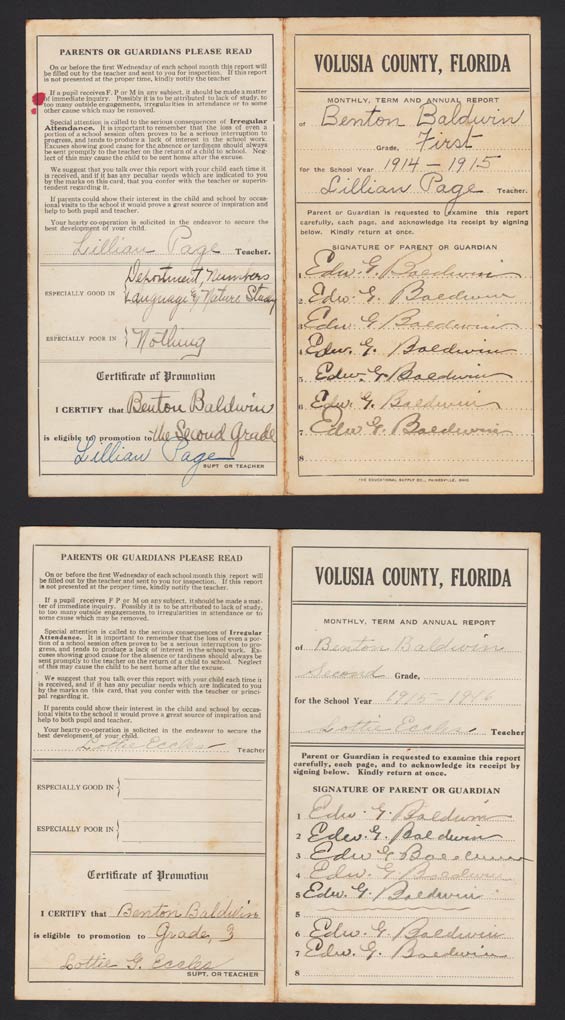 |
Benton R. Baldwin's Accounts Book, 1919 and Forward (Source: Denault)
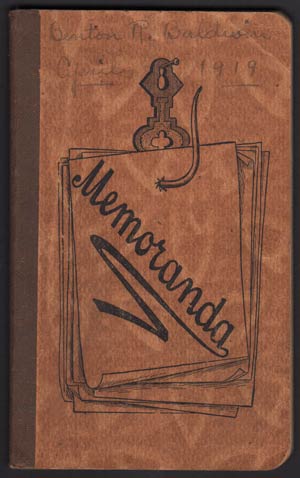 |
Because of site visitor L. Paul Denault, we have several windows into Lucky Baldwin's life. These consist of letters, booklets and newspapers, as well as artifacts related to his early life and military career. Curiously, there were no photographs of him or his family.
Thanks to Paul for his generosity and inviting me to his home to review Baldwin's artifacts. I spent September 15, 2011 with him scanning and photographing much of the following. Mr. Denault acquired the materials from the home of a deceased hoarder, who had been given the memorabilia by Baldwin's late wife sometime between when he died in 1995, and when she passed away in 2007.
From letters written among family members, principally by his mother, sister and brother-in-law, we learn Baldwin's early life was modest. Even though they were all educated and held jobs, money was short in his family. The artifacts and letters provide a refreshing insight into American life during the late Depression, and, pieced together chronologically, they follow Baldwin's aviation career from military to domestic to airline and back to military.
Beginning in 1919, at age 10, Baldwin kept a detailed, if sporadic, account of his income and expenditures. He kept his record in a small accounts book, which may be downloaded (8.4Mb PDF) in its entirety at the link. The cover and first two pages are adjacent and below. The handwriting on the cover looks like that of his mother. She may have presented this book to him as a training opportunity for keeping straight the details of his finances.
This small book comprises about 80 pages of even the most trivial expenditures. As a ten-year old, he must have raised chickens, since he maintained an income from eggs and "chickens mony," as well as from "errand mony," and a paper route. He was industrious at an early age, if not a good speller. Perhaps predictive of his future, on June 18, 1919 he spent ten cents on an "aeroplane." Keeping his options open in the transportation industry, on June 17th he had also spent a nickel on a "pony ride."
Benton R. Baldwin's Accounts Book, Pages 1 & 2 (Source: Denault)
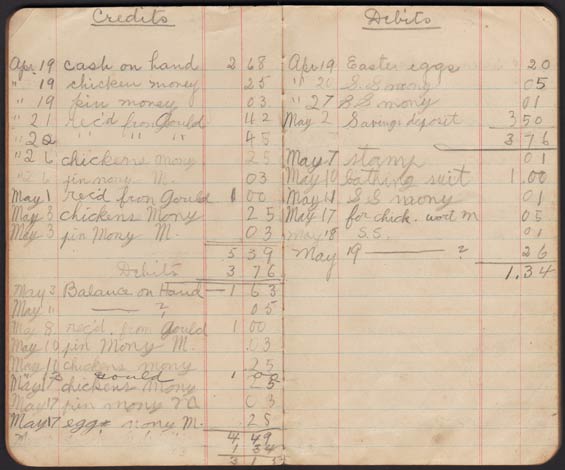 |
The following year, after he turned 11, he expanded his livestock holdings with pigeons and rabbits, with expenditures for "rabbit oatmeal" and "pigeon feed" and the attendant earnings of "squab money." Later he would expand further into "honey."
Curiously, on March 5, 1920 he entered a credit for 12¢ for "dice money." Sets of dice were among his memorabilia (see below). During this time his non-livestock expenditures were for boy things like "spokes," a "ball bearing," a "bicycle carrier" (75¢), "potatoes chips," "ice cream" and "pop corn."
From about the same period, below, a red, metal trimotor toy airplane is among Baldwin's memorabilia.
Benton Baldwin, Toy Trimotor Airplane (Source: Denault)
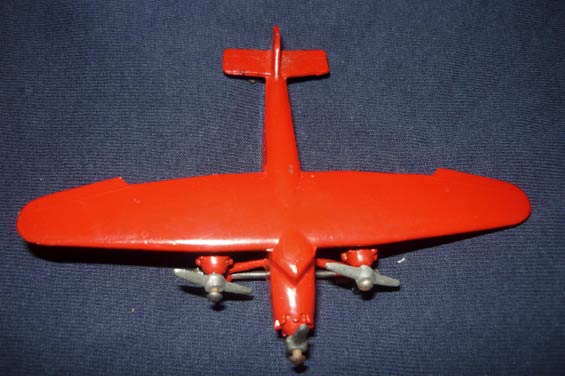 |
Benton Baldwin, Boy Scout, May, 1923 (Source: Baldwin Family)
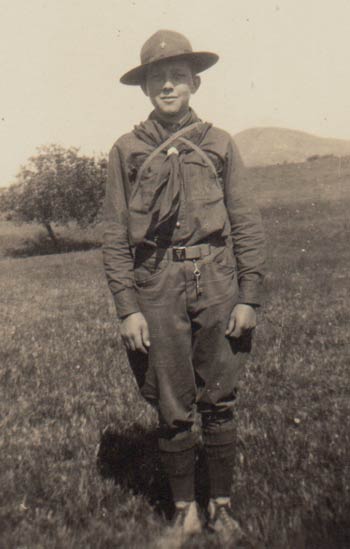 |
After about 1922 there is a five year hiatus in Baldwin's accounting entries. He was heavily into scouting. At right, from May, 1923, is a photograph of Baldwin about two years before he became an Eagle Scout.
He achieved Eagle Scout status, and we have an excellent record of his merit badge acquisitions and his interests during that period. Below are his badges arrayed on his sash typically worn by well-rounded Boy Scouts. He acquired his Eagle Scout rank June 16, 1925, as recorded on the white card.
Benton Baldwin Merit Badges, Ca. 1920s (Source: Denault)
 |
Below, two groups of the individual certifications for all his merit badges.
Benton Baldwin Merit Badge Certificates, Ca. 1920s (Source: Denault)
 |
He earned his badges from 1924-1925.
Benton Baldwin Merit Badge Certificates, Ca. 1920s (Source: Denault)
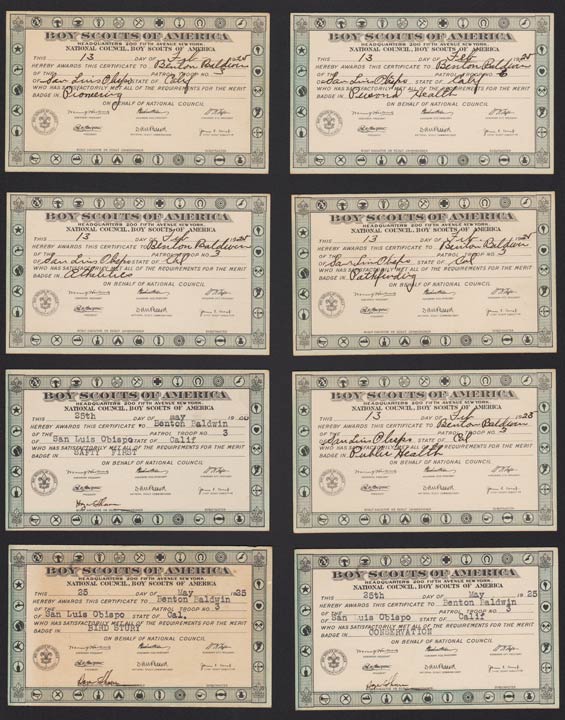 |
Mother of B.R. Baldwin, 1926 (Source: Baldwin Family)
 |
At right, from 1926, is a photograph of Baldwin's mother from a family album. Several letters from her are posted on Baldwin's biography page, linked above. From her letters, she was a generous and learned woman. She taught chemistry at the high school level and German at a local college.
This photograph of his mother was taken the same year Baldwin graduated from Ventura, CA high school. Below, an admission ticket for his graduation dated Friday, June 18th at 8:00PM.
Graduation Admission Ticket, 1926 (Source: Baldwin Family)
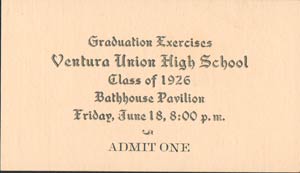 |
Below, the four-page commencement announcement and the listing of graduates of the Ventura, CA Union High School. Note that his mother is listed among the faculty as the sole chemistry teacher.
Commencement Announcement, June 18, 1926 (Source: Baldwin Family)
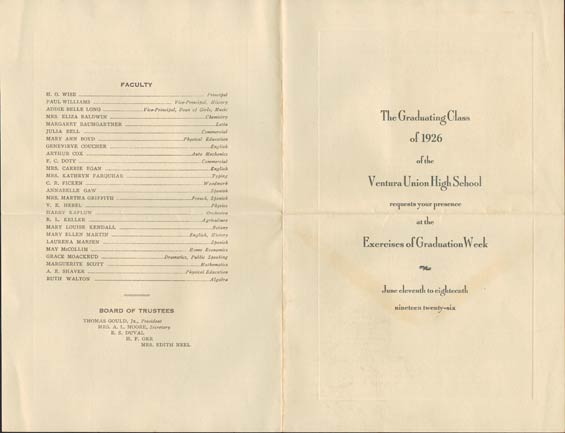 |
Note that festivities spanned an entire week.
Commencement Announcement, June 18, 1926 (Source: Baldwin Family)
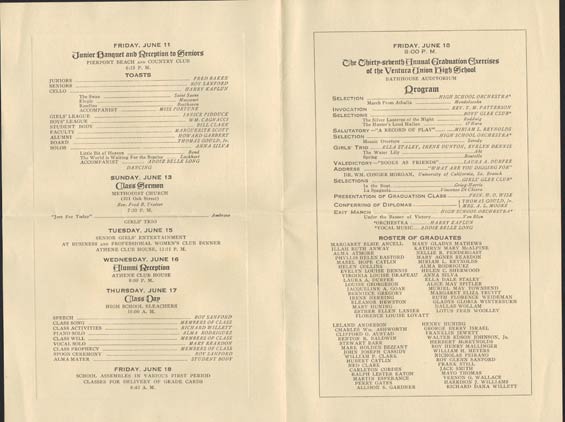 |
Below, his high school yearbook portrait for 1926.
Ideal Model Aeroplane Catalog, 1925 (Source: Denault)
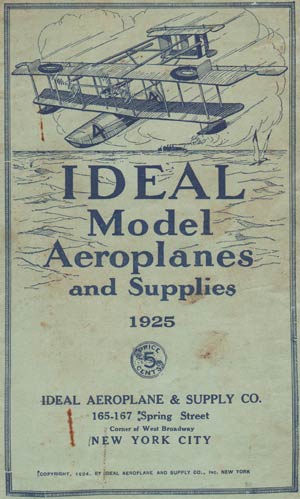 |
Benton Baldwin, High School Commencment Portrait, 1926 (Source: Baldwin Family)
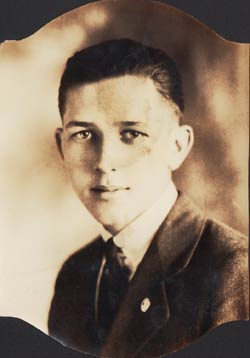 |
Among Baldwin's memorabilia from his adolescence is an Ideal model airplane catalog from 1925 (printed in 1924, the cover is at right). The catalog is downloadable (PDF 7.7Mb) in its entirety at the link. The date of the catalog approximates his Boy Scout work and predates by about a year his high school graduation. We can imagine him ordering and constructing an airplane model to partially satisfy his 'handicraft' badge. If you browse this catalog, you'll find no mention of plastic.
Back to his expense accounting, PDF page 13 begins "College 1927 expenses." His handwriting has changed, and his expenditures are now those of a 19-year old student at the California Institute of Technology (CalTech). Books, shoes, haircuts, dates and meals replace rabbit food and bicycle carriers. His interest in airplanes continued, as evidenced by his expenditure of 25¢ for "Aero Club Dues" on November 4th.
An automobile enters his life December 1, 1927, just before his 19th birthday. His account reads "Car $20.00." Expenses for gasoline and "license" show up December 9th. The Aero Club hosted a party on February 2, 1928, for which Baldwin paid $1.10. And his studies at CalTech produced expenditures for filter paper, sodium phosphate, electrodes, wire, condenser and fuses.
The following photograph shows up in Baldwin's collection, dated June 28, 1927. It is of the catastrophic failure of a Curtiss D-12 engine. Neither John Baldwin or your Webmaster have any idea why he would have the photograph, other than for general interest. These are official government photographs as evidenced by the identification markings at the bottom of each one. You can see the battered pistons and mangled rotating parts of the engine lying on the ground in the two left-hand images. The two right photos show what these loose parts, flailing uncontrolled at failure, did to destroy the robust aluminum crankcase of the big D-12.
Engine Failure, Curtiss D-12, June 28, 1927 (Source: Baldwin Family)
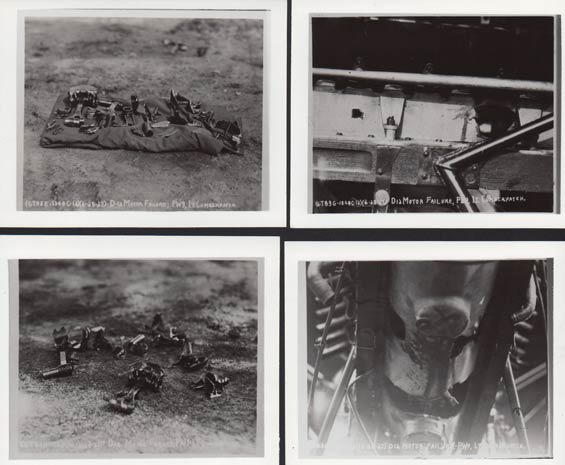 |
This series of photos would have been an excellent training aid for mechanics learning their trade at Kelly Field. The engine was in a Boeing PW-9 flown by a Lt. Cumberpatch (Oakland Airport Register pilot). Craig Fuller of aviationarchaeology.com provides the following accident report describing the event.
Filecode Date ACType AAFSN Sqdn Grp STA AF Action D Pilot
46009 270628 PW-9A 25-321 France Field, CZ FLEF 4 Cumberpatch, James T.
Cnty State Location Remarks ID
CZ France Field, CZ 227519 |
First Flight at Crissy Field, San Francisco, CA, Ca. July-August, 1931 (Source: Baldwin Family)
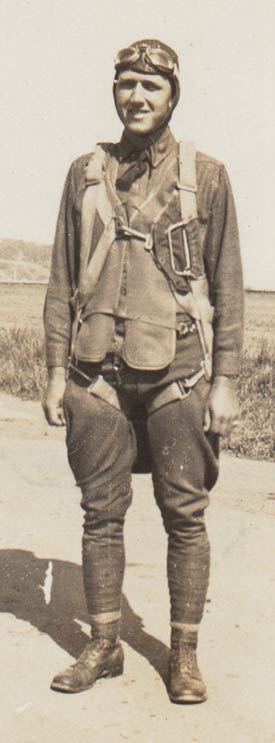 |
On September 12, 1928, Baldwin switched universities. His accounts, beginning on PDF page 22, now record expenses at University of California at Los Angeles (UCLA). On September 16th he spent $2.00 for "Air Races," which would have been the National Air Races held at Los Angeles that year from September 8-16. At the Races he would have seen the likes of fellow Register pilots Earl Rowland, Tex Rankin, George Zinn, Steve Wittman, M.E. Grevemberg, John Livingston, Eddie Ballough, John Wood, Jay Sodowsky and many others.
The air races must have focused his interest in aviation, because on January 5, 1929 he cites in his account "Airplane ride," which cost him the whopping sum of $10.00 (PDF page 32). When you consider his other expenses on the same page were generally for less than one dollar for things like meals, phone and presents, his airplane ride was a major splurge. He went on to buy an issue of Aero Digest on February 1st for 35¢, and nine gallons of gas for his car on February 21st for 95¢.
His accounting ends during May, 1929. Spend some time to browse his book and feel a sense of what finances were like for a pre-teen then teenage college boy in the 1920s. Baldwin attended UCLA from 1928-30; UC Berkeley from 1930-32. There is no notation in his NASM record as to whether he completed an academic degree program and according to his family, he did not.
He did complete some early flight training at Crissy Field, San Francisco as part of the Army ROTC program at UCLA. Then he attended the Air Corps Training Center, San Antonio, TX, 1932-33. At right and below, a photograph of him that is captioned as his first flight at Crissy Field.
First Flight at Crissy Field, San Francisco, CA, Ca. July-August, 1931 (Source: Baldwin Family)
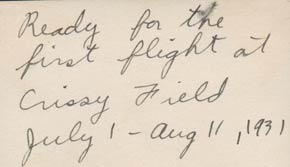 |
In July, 1931, while he was in San Francisco, he and brother-in-law Ed Kessel took a ride in an autogiro at the "S.F. Bay Airdrome." The aircraft, NC10761 (not a Register aircraft) is shown below 30 minutes after the pair rode in it.
Pitcairn Autogiro NC10761, July, 1931, San Francisco (Source: Baldwin Family)
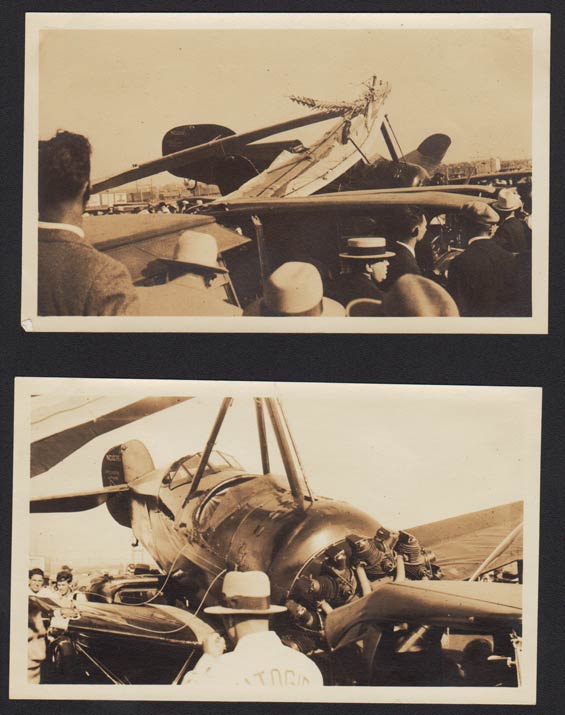 |
It appears that the aircraft crashed into a line of parked cars. It is not clear if anyone was injured. Below, Baldwin's annotation on the backs of the photographs.
Pitcairn Autogiro NC10761, July, 1931, San Francisco, Caption (Source: Baldwin Family)
 |
As sometimes happens, Register people and aircraft come together, in passing, more or less anonymously. An example of this is below with the Vought O2U-1 Corsair A-7829. This photograph was snapped by Baldwin not two months before it appeared at Tucson Tuesday, September 22, 1931. Please direct your browser to the link for a little more information.
Vought Corsair, A-7829, Crissy Field, 1931 (Source: Baldwin Family)
 |
Baldwin's annotation from the back of the photograph is below.
Vought Corsair, A-7829, Crissy Field, 1931, Caption (Source: Baldwin Family)
 |
Shortly after this, below, Baldwin's photograph was snapped standing with his mother (L) and sister.
Mother (L), B.R. Baldwin and Sister, August 9, 1931 (Source: Baldwin Family)
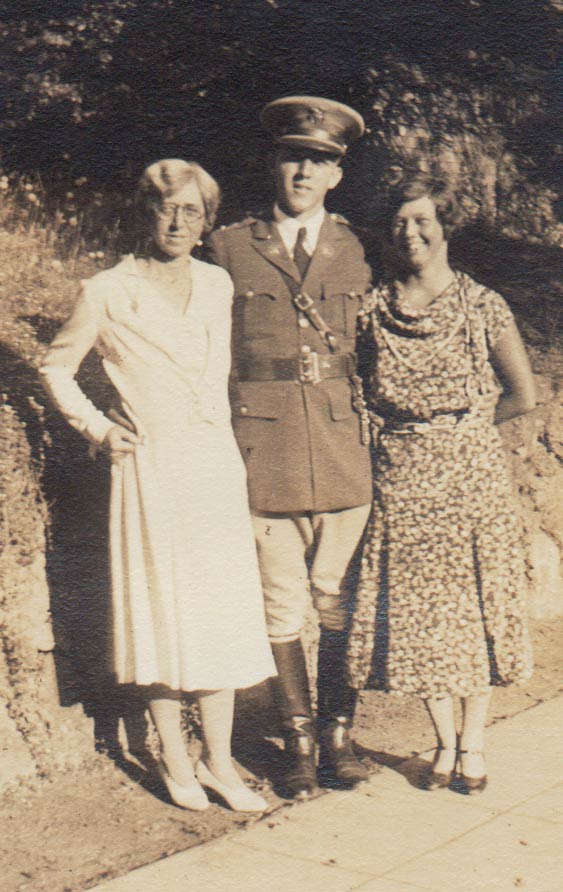 |
Below are snapshots of the U.S.S. Akron taken by Baldwin at Sunnyvale, CA. Of particular interest to Baldwin would be the aircraft retrieval mechanism that he captured in the lower right photo. To see this mechanism in action, please direct your browser to Register pilot Frederick Trapnell and the videos linked therefrom.
Scenes of U.S.S. Akron, Sunnyvale, CA, August 26, 1932 (Source: Baldwin Family)
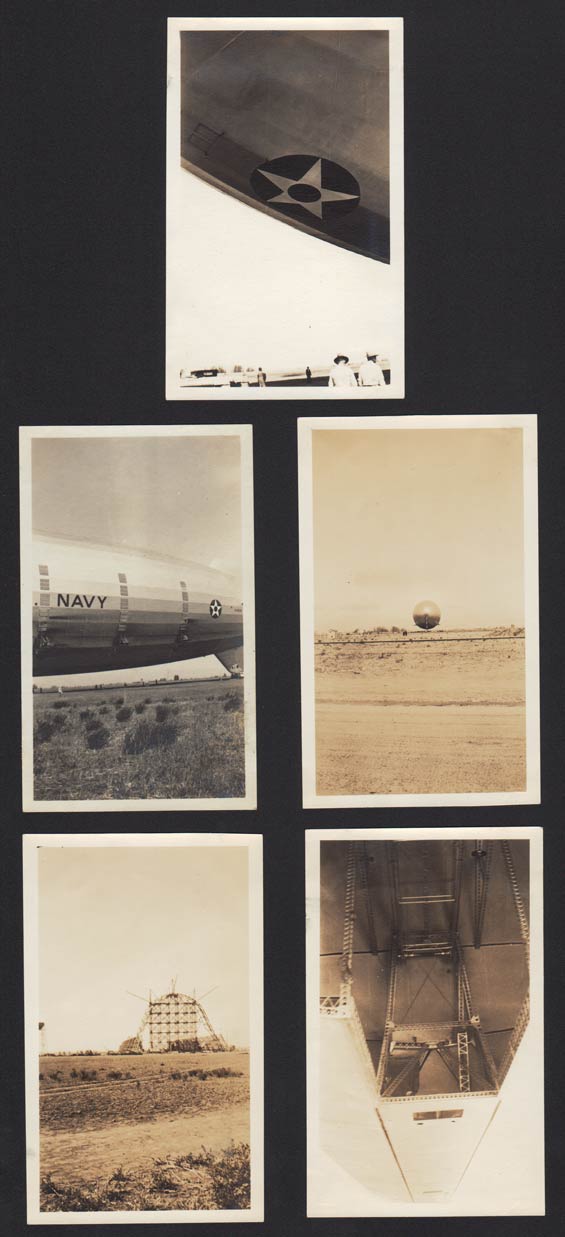 |
Baldwin married Flossie Gail Pinkerton of Riverside, CA on November 25, 1934. She was of the detective agency family. Below their wedding announcement.
Pinkerton/Baldwin Marriage Announcement, 1934 (Source: Baldwin Family)
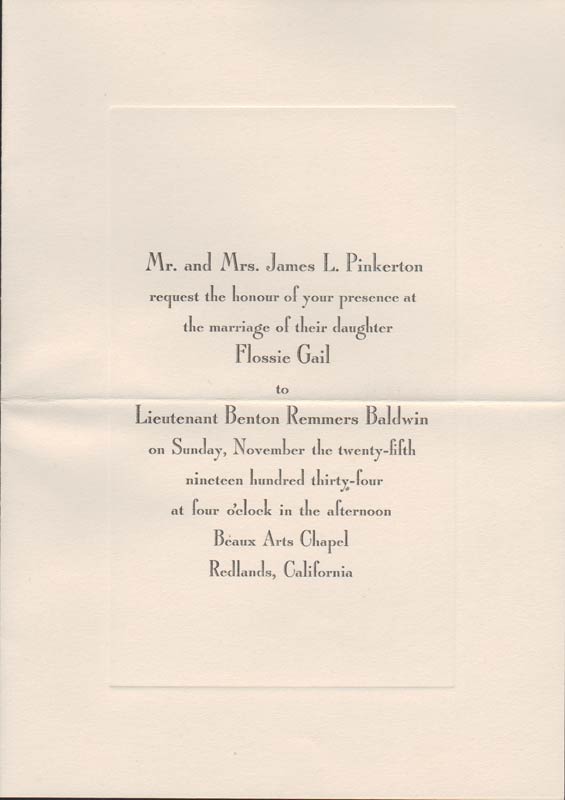 |
Below, their marriage certificate.
Pinkerton/Baldwin Marriage Certificate, 1934 (Source: Baldwin Family)
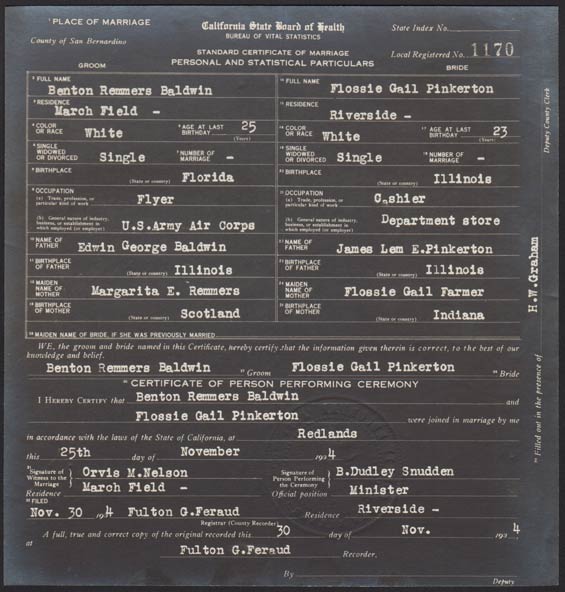 |
Below, an undated, unsourced news article. Besides the standard showers of orange blossoms and sheafs of Talisman roses, we learn that the couple was to reside at Hamilton Field, and that one of Baldwin's wedding party was Roscoe A. Dunahoo, who rode with Baldwin as passenger when he landed at Tucson, September 27, 1934, just a couple of months before his wedding.
Undated & Unsourced News Article, Pinkerton/Baldwin Wedding, November 25, 1934 (Source: Baldwin Family)
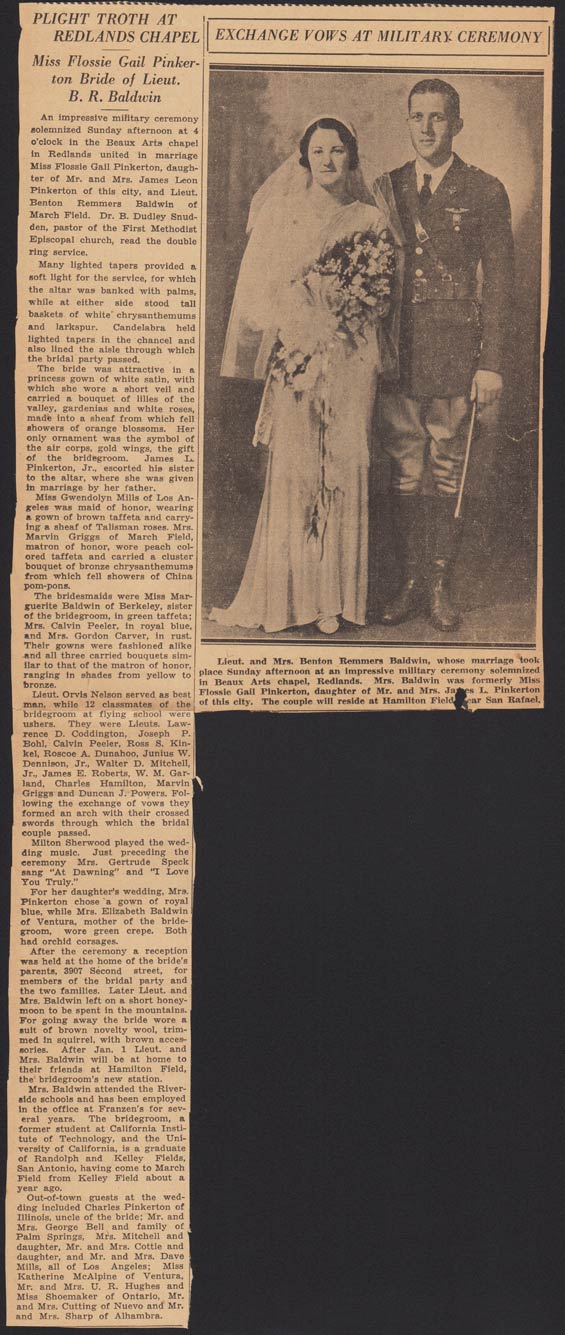 |
We also learn that they spent a short honeymoon in the mountains. Below, a membership card for the (then) exclusive Peter Pan Woodland Club, which opened in the 1920s and closed June 18, 1948, when the main club house was burned in an early morning fire. Although we don't know for sure, he may have bought this membership just for his honeymoon.
Peter Pan Woodland Club Membership Card, 1934 (Source: Baldwin Family)
 |
Below, a formal portrait from their wedding day.
Flossie Gail Pinkerton and Benton Baldwin, November 25, 1934 (Source: Baldwin Family)
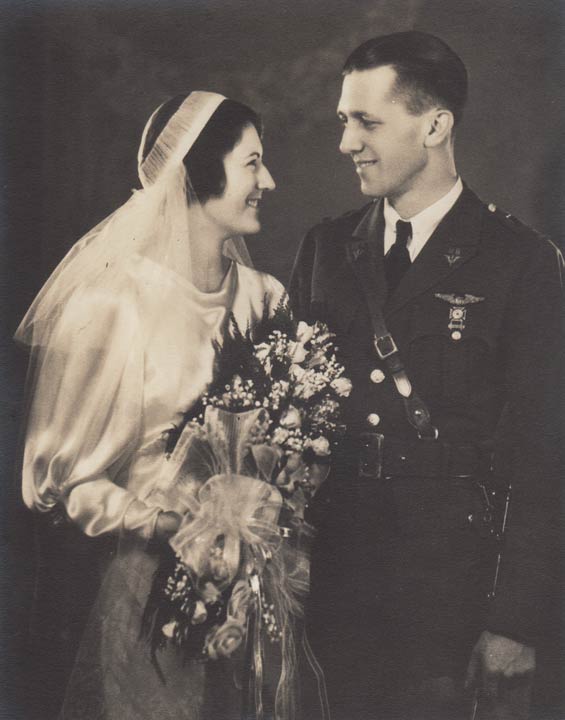 |
---o0o---
MILITARY CAREER
This section consists of 25 photographs and documents arranged more or less chronologically. It is, in-turn, divided into two sections, PILOT TRAINING and WWII. You will also find 19 PDF downloads available in this section.
PILOT TRAINING Baldwin received a 2nd Lieutenant commission in the Air Corps Reserve in May, 1932. According to his NASM dossier, Baldwin learned to fly in the Army Air Corps at San Antonio, TX. He was based at Kelly and Randolph Fields, San Antonio beginning in July, 1932 and was appointed as a flying cadet in October. He went through primary and basic flight training at Randolph and then Kelly Field for advanced training in bombardment for four months. He received his wings in October, 1933. He was one of 38 other men who completed the training out of a class of 124. Below, an official portrait of Cadet Baldwin taken just a few months before he graduated.
Benton R. Baldwin, Official Portrait, July 22, 1933 (Source: Baldwin Family)
 |
Mr. Denault shares with us a treasure from Baldwin's Randolph Field tenure. It consists of 12 monthly issues of The Tee (signifying a wind tee used by pilots to determine wind direction at field level; see the logo below). The first page of the October 31, 1932 issue follows.
Randolph Field, The Tee, October 31, 1932 (Source: Denault)
 |
The Tee was a tabloid-sized newspaper, "Published monthly by and for the Cadets of Randolph Field, Texas, 'The West Point of the Air.'" The issues that Baldwin kept run from from October 31, 1932 through October 6, 1933, the dates of his training.
| Issue |
Date |
| V. 1, No.11 |
10/31/1932 |
| V. 1, No.12 |
11/24/1932 |
| V. 2, No. 1 |
12/25/1932 |
| V. 2, No. 2 |
02/03/1933 |
| V. 2, No. 3 |
03/02/1933 |
| V. 2, No. 4 |
03/31/1933 |
| V. 2, No. 5 |
05/01/1933 |
| V. 2, No. 6 |
06/01/1933 |
| V. 2, No. 7 |
07/01/1933 |
| V. 2, No. 8 |
08/01/1933 |
| V. 2, No. 9 |
09/01/1933 |
| V. 2, No. 10 |
10/06/1933 |
Each individual issue is available as a separate PDF download in accordance with the table at left (file sizes near 4Mb each). Each will open in a separate browser window. Each consists of six pages. Each is a worthwhile browse, featuring anecdotes, poetry, sports and articles written by Cadet reporters of the early 1930s.
The newspapers are surprisingly literate with a pleasant tongue-in-cheek attitude. Nicknames were given to some Cadets, like, "Glide-stretcher Connally, renown for his PT annihilating ability...." Indeed, each Cadet is termed a "Dodo."
Each issue's back page includes a column titled "The Score," which summarizes the enrollment and attrition of the classes in residence. It is interesting to see, of those who start training, sometimes less than half finish. In fact, the three classes beginning during 1932 (before Baldwin arrived) graduated 41.0, 39.0 and 30.4 percent. Sadly, just about every issue included a memoriam for one or more Cadets. Luckier Cadets joined the Caterpillar Club.
Of relevance to pilot Baldwin, the May 1, 1933 issue of The Tee cites his becoming lost during a cross-country exercise. Although several columns appear throughout the newspapers that enumerate solo flights, Baldwin's solo is not among them. However, the average flight time until first solo flight was under nine hours for most Randolph Cadets.
The Tees of May and August, 1933 exhibited a pair of two-page photographs of the graduating classes of March and July that year. Below are those photographs.
Cadet Graduating Class, March, 1933, Randolph Field, San Antonio, TX (Source: Denault)
 |
I have posted these photographs in vertical format at the links cited above for visitors who might want a larger size image to explore. Just download and turn them 90 degrees in your photo editor. The names of each airman are listed.
Cadet Graduating Class, July, 1933, Randolph Field, San Antonio, TX (Source: Denault)
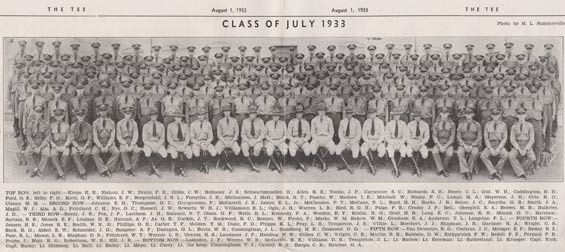 |
Below, photographs of Baldwin with Kelly Field aircraft from May and June, 1933 just before he went to bombardment school.
Cadet Baldwin With Kelly Field Aircraft, May-June, 1933 (Source: Baldwin Family)
 |
As alluded to above, at the time Baldwin was there Randolph Field was known as the "West Point of the Air." Fellow Register pilot F. Trubee Davison had landed at Randolph in 1929 and used the name in a speech he gave, which encouraged the development of Randolph Field as a major flight training center. The facility wasn't very old before Baldwin arrived.
Another useful artifact among Baldwin's collection is this "Roster of Students of The Air Corps Primary Flying Schools," (PDF, 88pp.,14Mb) which includes lists of students who received training between September 1922 and October, 1932 at Brooks, March and Randolph Fields. It is, as you can imagine, a storehouse of names of Register pilots. The cover of the book is below.
"Roster of Students of The Air Corps Primary Flying Schools," 1922-1932, Cover (Source: Baldwin Family)
 |
Below, at random from the book, is the Brooks Field class of March-July, 1928 found on page 21. Among Register pilots listed on this page are E.H. Alexander, Roger Batchelder, Frank Armstrong and C.P. Gilger. Baldwin is cited on page 41 with the class of October, 1932.
"Roster of Students of The Air Corps Primary Flying Schools," 1922-1932, Page 21 (Source: Baldwin Family)
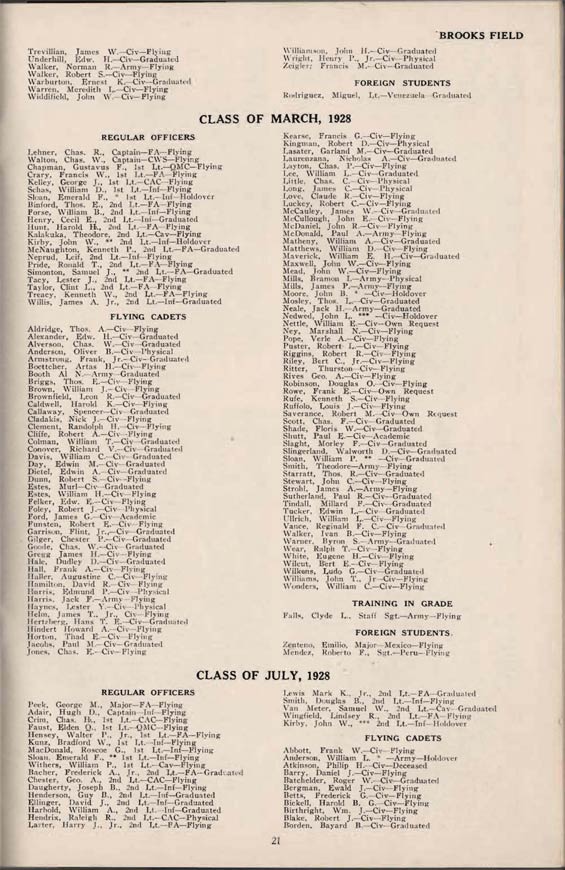 |
Like many other Cadets, after Randolph Field, Baldwin moved to Kelly Field for advanced flying school and specialized in bombardment. From 1933-34 he was stationed at March Field, Riverside, CA with the 9th Bombardment Squadron. It was during this time we find him at Tucson. Interestingly, among his possessions is an order cut that assigned him to Brooks Field, San Antonio, TX (PDF 1.5Mb) for the rest of 1933 and into 1934.
About this time he acquired his civil Department of Commerce transport license (#), which is pictured below. It appears he used a clipping from his formal 1933 portrait, above, as his ID photo. This license certified him to carry passengers for hire, which he would do in just a few years when he left the military and joined United Air Lines.
R.B. Baldwin Civil Transport License Issued February 1, 1934 (Source: Baldwin Family)
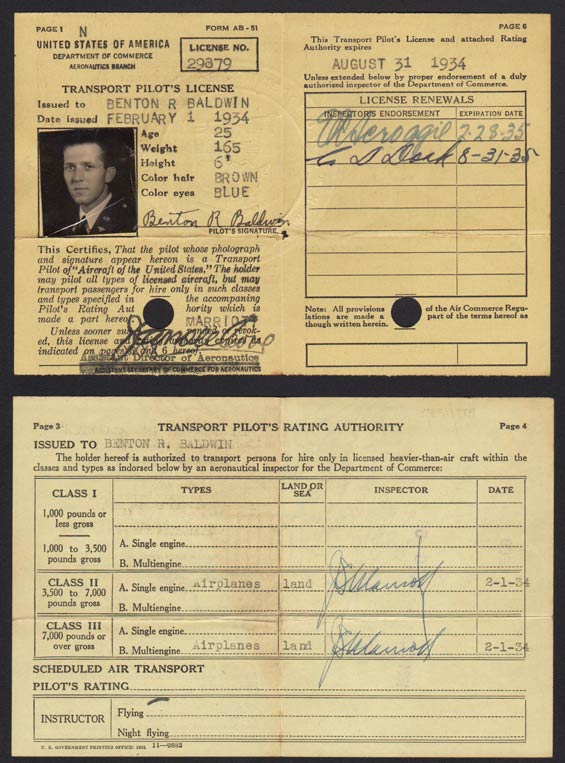 |
"Lucky" Baldwin landed once at Tucson on Thursday September 27, 1934. He carried a single passenger, Lt. Roscoe A. Dunahoo. Based at Riverside, CA, March Field, they were flying a Martin YB-12-A. They appear to have been on a round-robin flight from March back to March. They stayed on the ground 4.5 hours through the lunch hour before departing westbound. They gave no reason for their flight. Baldwin's twin-engine airplane, the type is shown at aerofiles.com at the link above, was not identified by number, but it was somewhere between 33-155 and 33-161, as there were only seven made according to the National Air Force Museum. All were off the Army's rolls by September, 1942. Documentation for his landing is recorded not only in the Register, but also in his pilot log book for July 6, 1933 to August 28, 1935 (PDF 11.0 Mb; see the section PILOT LOG BOOKS for information about his six log books). A photo of Baldwin with a Martin bomber of the same model is below. It is unknown if it is the same aircraft he brought through Tucson. The photograph of the automobile and Baldwin is dated 1934; the airplane is from April 11, 1935.
Baldwin, Aircraft, Automobile, Ca. 1934-35 (Source: Baldwin Family)
 |
Baldwin saved two social event documents from 1935. The first, from the May 4, 1935 "Whing Ding" at March Field, is below. It is a single-fold menu and schedule for the event. Note that Register passenger Harold Gatty and pilots J.H. Pirie, H.H. Arnold and Clarence Tinker participated in the latter.
March Field, "Whing Ding," March Field, May 4, 1935 (Source: Baldwin Family
)
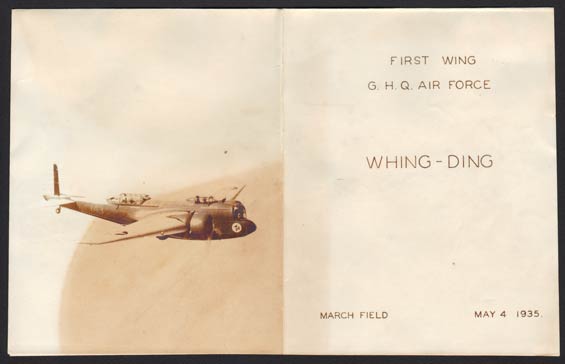 |
March Field, "Whing Ding," March Field, May 4, 1935 (Source: Baldwin Family)
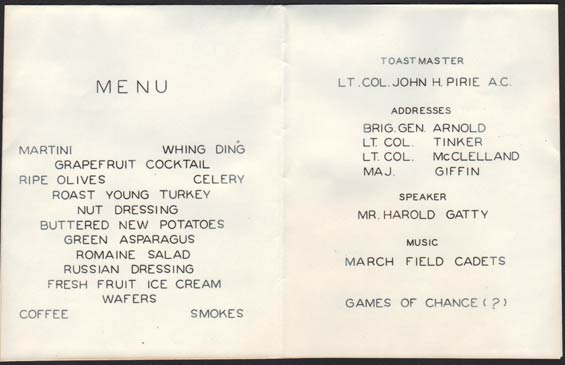 |
A few days later the opening of Hamilton Field was celebrated as below. Arnold and Tinker were again involved in the ceremonies.
Hamilton Field, Dedication, May 12, 1935 (Source: Baldwin Family)
 |
Hamilton Field, Dedication, May 12, 1935 (Source: Baldwin Family)
 |
A couple of months after these festivities, Baldwin and his crew took a Martin bomber to 25,000 feet or so and made news in the San Raphael Independent for July 31, 1935, below. Compare this flight with some of the ones flown by Register pilot Apollo Soucek.
San Raphael Independent, July 31, 1935 (Source: Baldwin Family)
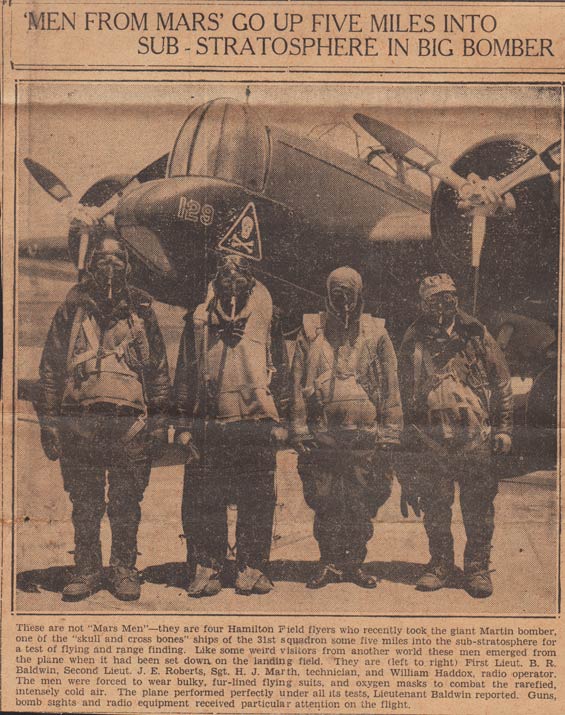 |
At some point in his military career Baldwin compiled an alphabetical listing of all the Army air stations in the country, from Ft. Adams to Wright Field. The list is six pages long and is handwritten. The list includes approximate distances and bearings from the nearest town. On page six he includes a short list of National Guard posts. The first page of his document is below. The rest of the list is available as a PDF download (2.4Mb) at the link.
The paper he used was from the Stephen F. Austin Hotel in Austin, TX, which is still in business. The stationery from Texas suggests the list was compiled during his time at Randolph or Kelly Fields. I'm not sure if it was compiled as a learning experience during his training, or perhaps in preparation for a grand tour of facilities by him or his superiors. There was no record of his making a trip of this sort.
Undated List of Air Corp Stations, Page 1, Ca. 1930s (Source: Denault)
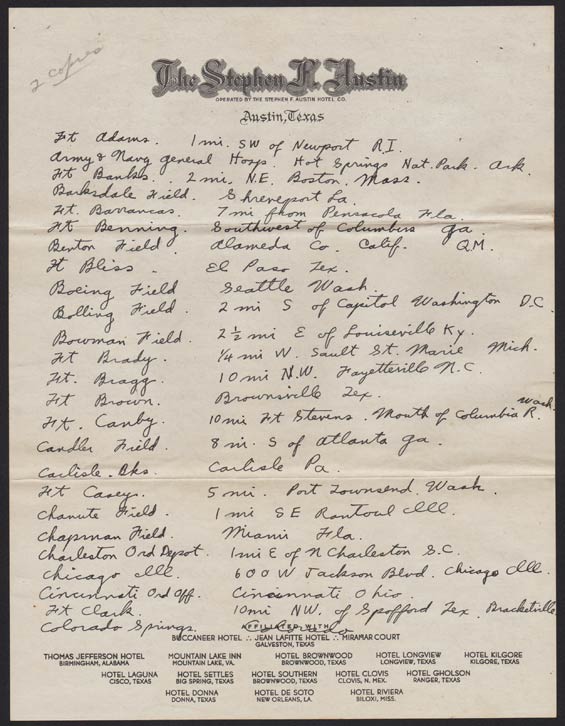 |
Below is half of a souvenir silk pocket square commemorating the Olympic Games. Trivia question: Where were the games held, and what year does the silk commemorate?
Olympic Games Souvenir Silk Pocket Square (Source: Baldwin Family)
 |
Shortly after his visit at Tucson, Thursday, August 27, 1934 he was released from military duty. He received his 1st Lieutenant commission on January 22, 1936 and spent two periods of two weeks on active duty in this grade in 1939 and 1940. He flew with United Air Lines until mid-1942 when he was called up for active duty again.
In an informal autobiography among his artifacts, Baldwin recounts the world-broadening results of the flight training he began with the Army in 1932. He described it as, ".... extensive travel all over the United States during seven years as a pilot on United Air Lines, and foreign travel for 4-1/2 years in the Army again from 1942 to 1946, and foreign travel as a pilot on Transocean Air Lines [see below] for almost four years. During this foreign travel I have visited and spent varying amounts of time in almost all the countries of Europe, North and West Africa and the Mediterranean Area, the Middle East, Iran, Pakistan, India, Azores, Bermuda, Iceland, Labrador, Greenland, Newfoundland, North and Northeast Coast of South America, Hawaii, Philippines, Australia, Japan, China, Korea, and a good many Islands in the Pacific."
---o0o---
B.R. Baldwin, Passes, SHAEF & Other Passes, March, 1945 (Source: Baldwin Family)
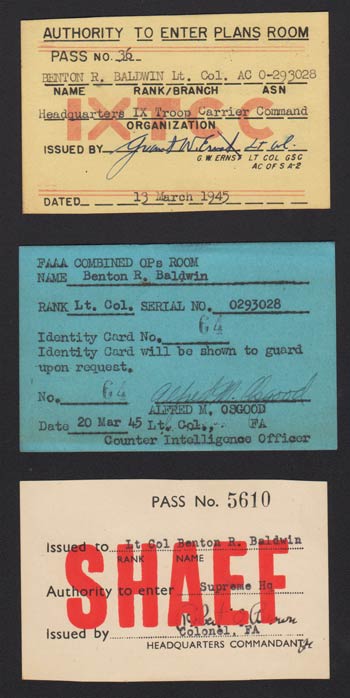 |
WORLD WAR II Baldwin played a key role in the invasion of Normandy, "Overlord," as follows. Leaving United Air Airlines on May 18, 1942 as a1st Lt. in the Reserves, he was promoted to Captain on June 30, 1942. He was assigned as Operations Officer and Pilot Instructor in Troop Carrier Transition Training. He was promoted to Major January 22, 1943 and took the 29th Troop Carrier Squadron to North Africa in April, 1943.
He was immediately involved with his Squadron in the invasion of Sicily. Later, in Sicily, he was promoted to Lt. Colonel on September 23rd, left the Squadron in November, 1943 and transferred to the operational planning staff of the 12th Troop Carrier Command in Palermo, Sicily. There he developed a school for training glider pilots in combat infantry tactics (think ahead to D-Day). He evaluated operational possibilities and availability of all radar, radio and visual navigational aids and made recommendations and requisitions for equipment. With these and the logistics for same, he moved his whole command, now organized as the IX Troop Command, to England in January, 1944.
In England, he worked with British troop carrier units to coordinate logistics and to lay out routes for all airborne combat missions, including maps of all drop zones and landing zones. He organized a combined Troop Carrier Pathfinder training group and Airborne Pathfinder personnel.
He was also engaged in planning and experimenting with new facilities and techiques for paratroop operations, including rendezvous and route schedules. Part of this was preparing and installing radar, radio and visual navigational aids, including on boats across the English Channel, for the airborne support of D-Day.
His responsibilities were more forward-looking. He assumed the invasion of Europe would be successful and designed and ultimately implemented the first and only lighted airway in Europe for night hauling of supplies to forward airdromes.
His responsibilities included also the planning of airway traffic control and England and Europe and planned and proposed radio and navigational aids for heavy density air routes in post war Europe. Above, right are passes, including one for the Supreme Headquarters, Allied Expeditionary Force (SHAEF), issued to Baldwin for entry into authorized areas.
"Overlord" was not the only campaign he served in as a European Theater Operations Staff Officer. He participated in the Sicily campaign (May 14-August 17, 1943), Naples-Foggia (August 18, 1943-January 21,1944), Normandy (June 6-July 24, 1944), Northern France (July 25-August 1, 1944), Rome-Arno and Southern France (August 2, 1944-September 9, 1944), Rhineland (see below; September 15, 1944-March 21, 1945), Ardennes-Alsace (December 16, 1944-January 25, 1945) and Central Europe (March 22, 1945-May 11, 1945). He also served in the Pacific Theater from August 20, 1945 to April 9, 1946.
He was directly involved with classified planning of various airborne and glider operations until the end of the European war. A very interesting document among his Collection is this "Engineer Report on Airfields on the Continent in Western Europe" (PDF 9.3Mb). Classified as SECRET at the time it was published on March 15, 1945, a unique attribute of this document is that latitude and longitude coordinates for each airfield are tabulated. If you're an historian of WWII aviation in Europe, this is a great resource for you.
With this document and Google Earth, you will find that many of the old WWII fields still accommodate aircraft, such as the sod field at Besancon/Thise (find the lat/long on document page 3 of 8), the paved field at Aachen (page 4 of 8) and Darmstadt (coordinates penciled in by Baldwin on page 8 of 8). Whereas others, such as Auxerre (page 8 of 8) show no trace of an airfield. That area is now occupied by light industrial structures. Please let me KNOW if you find anything significant with any of the other coordinates.
Below, a montage of 35mm ID-type photographs ca. WWII. Exact date and location of these photos is unknown.
ID Montage, 35mm, Date Unknown (Source: Baldwin Family)
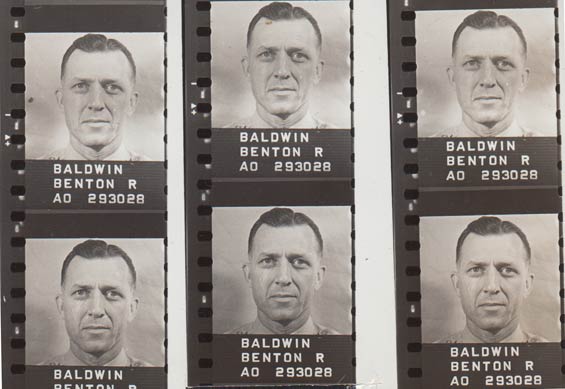 |
Baldwin was recalled to the U.S. in June, 1945 for a special project, but the project was abandoned before he arrived. Instead, he was sent to the Pacific Theater with a newly staffed 9th Troop Carrier Command as the only Operations Officer with combat experience. In the Philippines (and ultimately in Tokyo) he set up Army Air Routes and schedules, organized jump training for new airborne recruits and a training school for mechanics and pilots on C-54 aircraft. He returned to the U.S. in the middle of April, 1946 and was released from active duty on August 23, 1946.
As a member of the Air Lines Pilots Association (ALPA), Baldwin appears in an article in the organization's News publication late in WWII. ALPA's review of his work is glowing, and perhaps Baldwin exerted his modesty with the penciled note at the end of the article.
B.H. Baldwin, Air Line Pilots Association News, January, 1945 (Source: Baldwin Family)
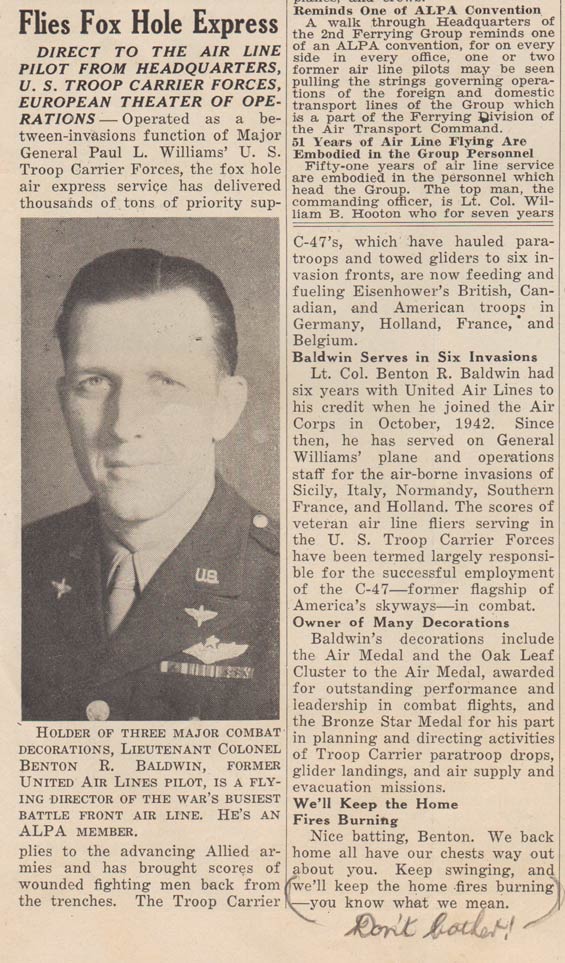 |
On March 24, 1945 he participated in Operation Varsity, an allied paratroop drop across the Rhine River into Germany. Baldwin flew a B-17 carrying reporters and combat cameramen to record and report on the air drops. Below, a photograph of the drop operation taken from Baldwin's B-17.
Operation Varsity, March 24, 1945 (Source: Baldwin Family)
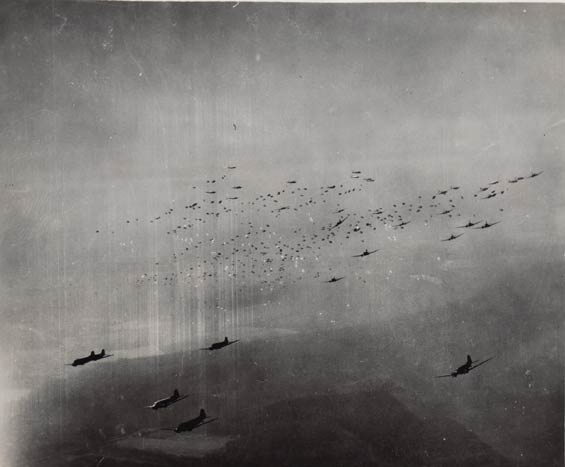 |
If you google "Operation Varsity" you will find this very photograph posted several places on the Web. It was taken from Baldwin's airplane that morning. A movie of what it was like to be in one of the C-46/C-47s near the same instant is at the link. Below, the caption on the back of the photograph above. Operation Varsity was the largest air drop of troops in history. It was also the final paratroop operation of WWII. Baldwin's experience in Operation Varsity, as well as his verbal description of it, is documented in his MOVIE described and linked at the top of this page. Go to the link and click on Baldwin_Movie.
Operation Varsity, March 24, 1945, Caption (Source: Baldwin Family)
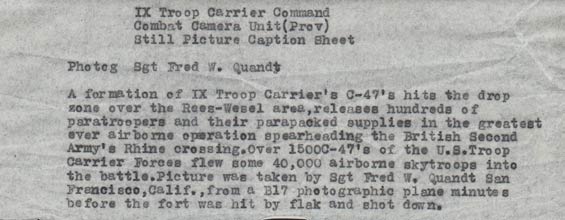 |
But that's not all. During the Operation, Baldwin's B-17 was hit by flak which started a fire on the left wing. He managed to get the airplane back over friendly territory and had the passengers bail out. Despite the growing fire on the wing, he was unable himself to bail out, because, in the process of donning his parachute he pulled the ripcord spilling the chute in the cockpit.
An article in Collier's Magazine, May 5, 1945, entitled "Big Jump into Germany," (PDF 1.1Mb) gives perspective on the flight from the viewpoint of author Richard C. Hottelet, who was one of the reporters riding in the B-17 that day. He reports on the route of the flight, as well as the flak incident, fire and aftermath. His article in Collier's was, "Radioed from Paris." The article is worth reading, as Hottelet was one of the premier reporters of WWII news.
Baldwin belly-landed the B-17 in a field and escaped relatively unharmed. Below, the result of Baldwin's crash landing taken from movie film shot from another observation aircraft.
Operation Varsity, March 24, 1945 (Source: Baldwin Family)
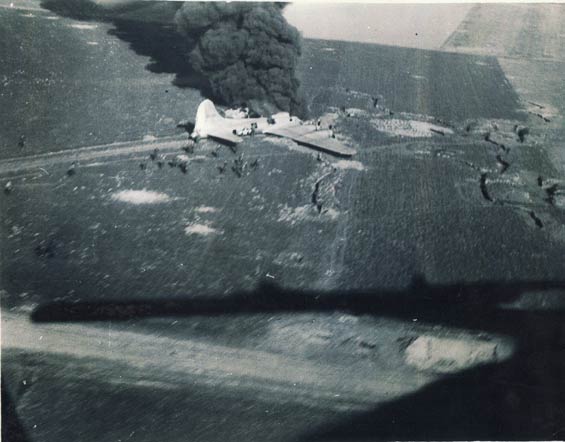 |
The motion picture documents this scene as well. Baldwin was awarded the Distinguished Flying Cross for his efforts. Local newspaper accounts, two of which are shown below, appeared over the next few months that documented his participation in Operation Varsity and his forced landing.
Cleveland (OH) Plain Dealer, June 15, 1945 (Source: Baldwin Family)
 |
Mill Valley (CA) Recorder, August 16, 1945 (Source: Baldwin Family)
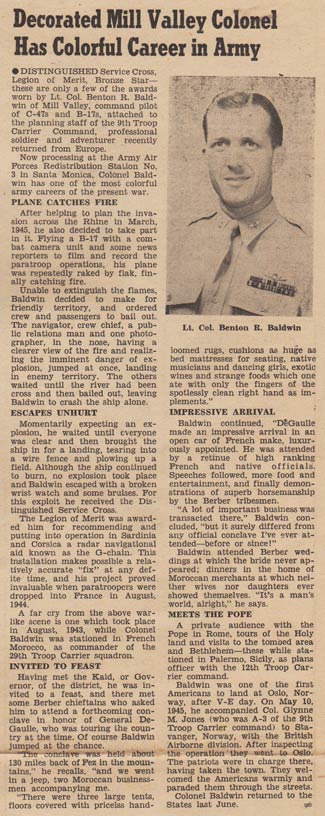 |
Below, a swatch of painted aircraft fabric bearing the coat of arms of the Italian House of Savoy, ca. 1940s. It is unknown how or why Baldwin acquired this artifact, which appears to be a decal of the arms applied over the painted surface of the fabric. It was probably cut from the fuselage of an Italian aircraft.
Aircraft Marking on Fabric, House of Savoy, Italy, Date Unknown (Source: Baldwin Family)
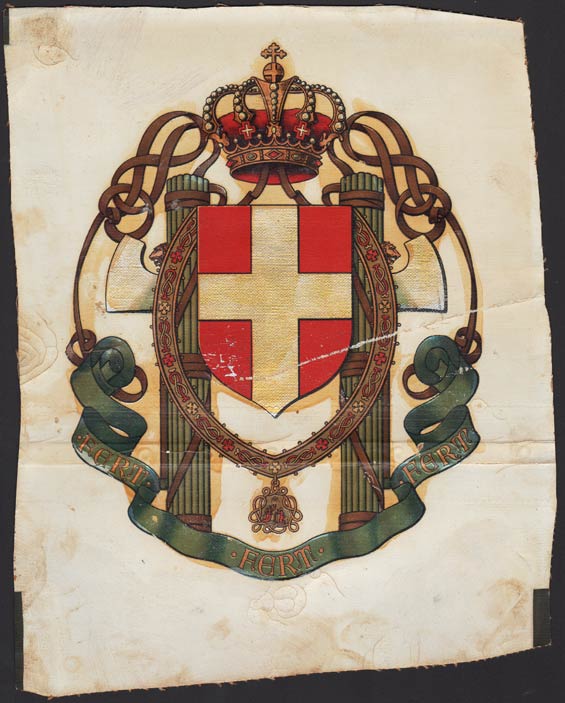 |
Below, the back of this piece of fabric, showing the indentations of a line of rivets.
Aircraft Marking on Fabric, House of Savoy, Italy, Back (Source: Baldwin Family)
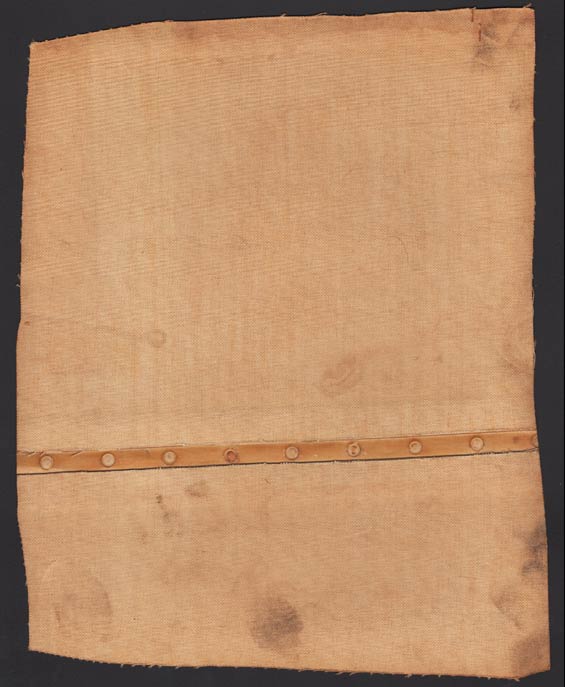 |
---o0o---
CIVIL CAREER
This section consists of 18 photographs and documents arranged more or less chronologically. Baldwin was a long-time employee of United Air Lines (UAL), from ca. 1934-1942, and from 1946-1952. He was hired as a copilot with UAL in April, 1936, after receiving his Transport license (#29879) while still in the Army in 1934. He was promoted to Captain in July, 1939 and served in that capacity with UAL until May 18, 1942 when he was called back into the Army (see above).
Below is a portrait of him with an unidentified UAL aircraft taken at LaGuardia Airport, New York, NY in 1941.
B.R. Baldwin with UAL Aircraft, LaGuardia Airport, NYC, Ca. 1941 (Source: Baldwin Family)
 |
Before he went back into the Army, Baldwin saved many examples of the day-to-day paperwork required of his job. Below, an example of one of a hundred or so expense vouchers that Baldwin kept among his documents. This one is dated February-March, 1937 and shows a total of $26.25 for meals and lodging for the period when he was a second pilot.
UAL Expense Voucher, February-March, 1937 (Source: Baldwin Family)
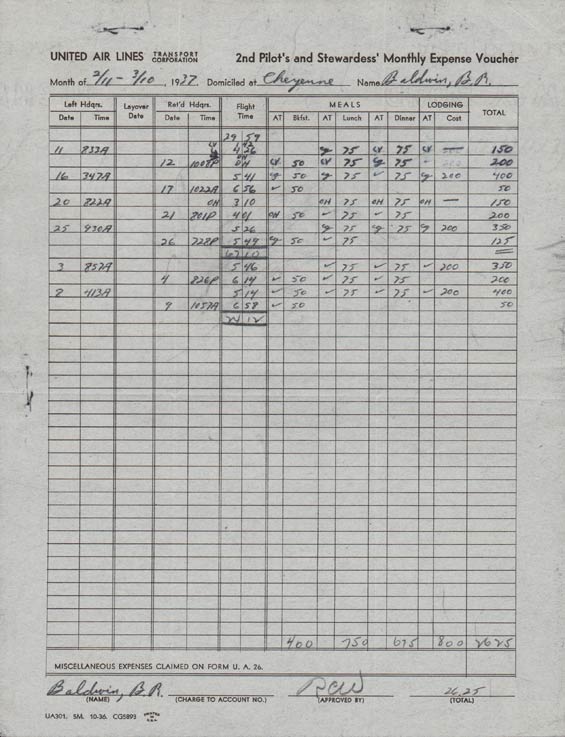 |
Below, a pay voucher for January, 1942. The detail on this form is intimidating, resulting in pay for the month amounting to $518.06. Given his practice with his personal accounts book as a 10-year old, he probably took this bookkeeping in stride.
B.R. Baldwin, UAL Pay Voucher, January, 1942 (Source: Baldwin Family)
 |
B.R. Baldwin, NJ Driver's License, 1938 (Source: Baldwin Family)
 |
At right is his drivers license for New Jersey, 1938. He was lean at 6' and 160 pounds.
In the Reserves in 1938, Baldwin maintained his pilot rating, as directed in this memo from fellow Register pilot Ira Eaker.
Ira Eaker, Memo, April 1, 1938 (Source: Baldwin Family)
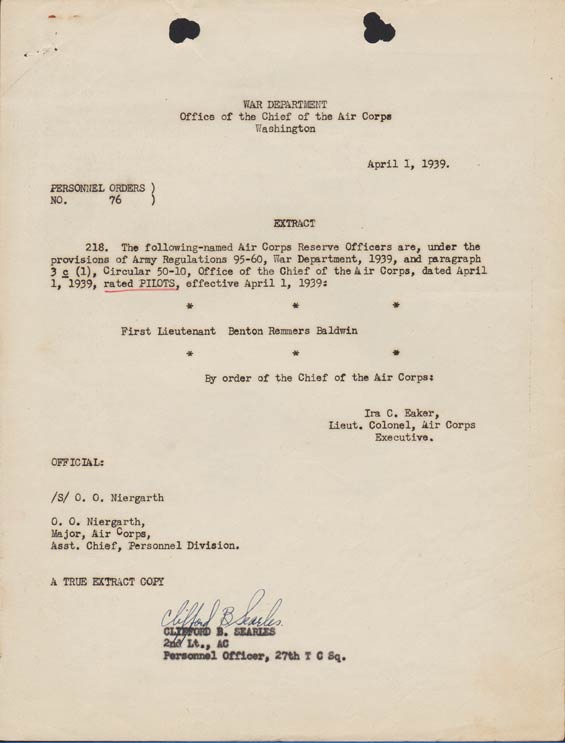 |
Below, an unsourced news article from 1939 describes UAL staff together for an annual "frolic." The attendees were an eclectic mix of workers, pilots and business types.
Airport Dedication Ribbon, Harrisburg, PA, November 3, 1838 (Source: Baldwin Family)
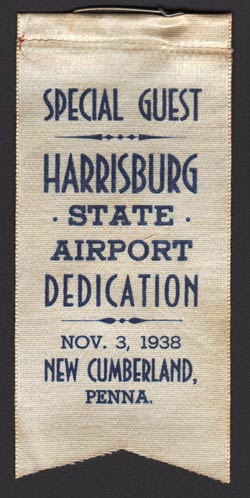 |
Unsourced News Article, 1939 (Source: Baldwin Family)
 |
Part of Baldwin's responsibilities with the Army and with UAL was to attend dedications of new airfield facilities as needed. Above is a white ribbon citing the dedication of Harrisburg State Airport in Pennsylvania. He was stationed in New Jersey at this time, so it was easy for him to travel to Harrisburg for the dedication. Likewise, it was easy to get to Philadelphia for the annual Army-Navy football game on November 26, 1938, below.
Army-Navy Football Game Ticket, November 26, 1938 (Source: Baldwin Family)
 |
He modeled trenchcoats (London Fog brand?) at least once and the photograph below shows him and an unidentified UAL colleague in fresh trenchcoats. They are walking in front of the DC-3-A NC16063, S/N 1903 Mainliner "City of San Francisco." A model of this airplane hangs today from the ceiling of the museum located at the San Francisco International Airport.
Trenchcoat Ad Photograph, Ca. 1940s (Source: Baldwin Family)
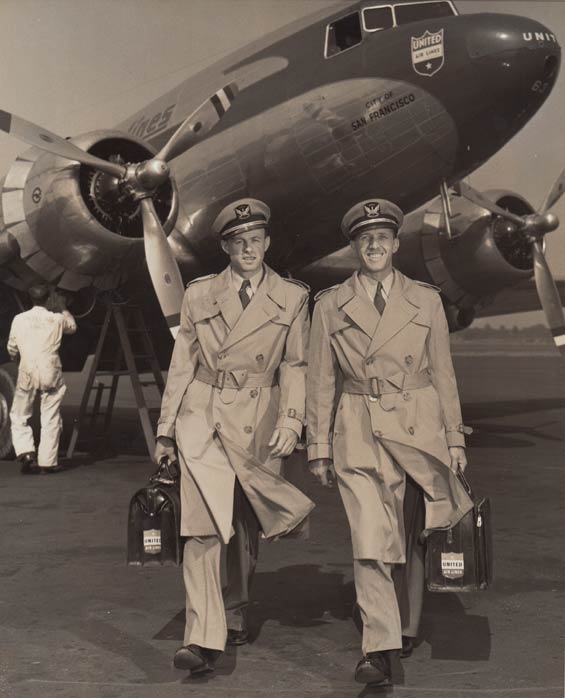 |
He returned to UAL from the Army on June 22, 1946. He took transition training and exams for flyng the DC-4 aircraft, which he passed in November, and for the DC-6 in April, 1947. On May 29, 1947, Baldwin was Captain and pilot in command of a scheduled UAL DC-4 on takeoff from La Guardia Airport. His airplane crashed before takeoff and resulted in 44 deaths (42 according to some accounts) including his copilot. The legal and fact-finding aftermath of the accident was long, and discussions focused on whether an "'unprecidented shift' in wind" was to blame. Below, an article from The New York Times of June 12, 1947 hints at the uncertainty.
The New York Times, June 12, 1947 (Source: Baldwin Family)
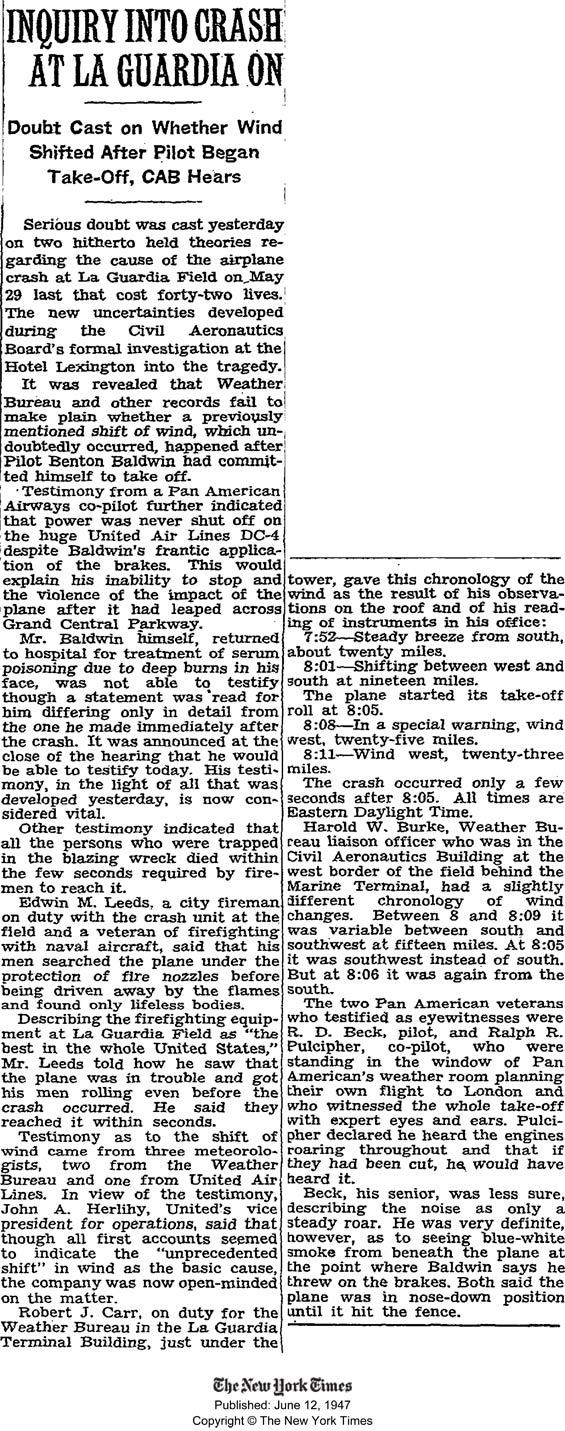 |
Before any decision was made as to culpability, Baldwin was removed from the payroll and ultimately fired by UAL saying he had failed to exercise good judgement. This in the face of the fact that Baldwin had always been recognized by the company as an exemplary employee with impeccable judgement and, "... a pilot of outstanding ability and integrity." Below, an article from The New York Times of June 13, 1947, which cites Baldwin's own testimony.
The New York Times, June 13, 1947 (Source: Baldwin Family)
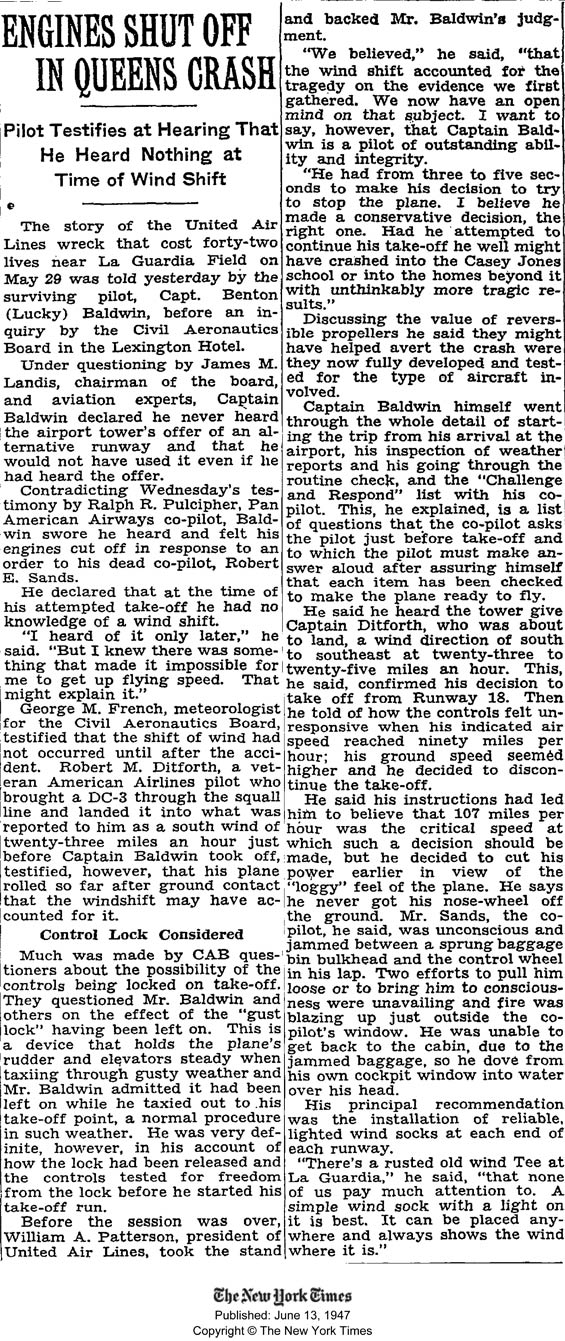 |
Because of the accident, Baldwin remained in limbo as to culpability until 1951. Below, the ALPA News of December, 1951 reports on Baldwin's legal reinstatement to UAL after they had earlier dismissed him without due process.
B.H. Baldwin, Air Line Pilots Association News, December, 1951 (Source: Baldwin Family)
 |
Transocean Air Lines Business Card, Ca. Late 1940s (Source: Baldwin Family)
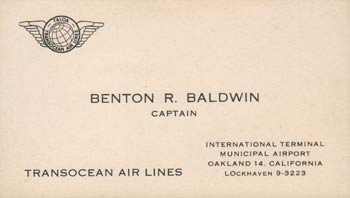 |
The UAL case went on in parallel with Baldwin's initiative to keep flying. About five months after the accident he joined the Oakland, CA-based Transocean Air Lines on October 8, 1947 and began flying to Europe, the Mediterranean and South America in DC-4 and DC-6 aircraft. From December, 1947 to March, 1948 he was in Berlin representing Transocean Air Lines to the Civil Aviation Branch of the U.S. Military Government of Germany. In September, 1950 he started flying to Tokyo in the Military Air Transport Service (MATS) contract for Transocean. The Air Transport Command began the service of transporting materials during WWII. MATS continued that service, so with his military transport experience it was natural for Baldwin to work for them.
An interesting passage in his informal biography documents what it was like to fly as Captain for Transocean, an international, unscheduled airline. He cites, "... landing at many placese where there are no company representatives, and flying over many new routes into numerous unfamiliar airports day and night, the duties and and responsibilities of the captain are multitudinous. I have had to collect and count revenues, obtain visas and landing permits, send and receive operational and administrative messages in many foreign countries, handle currency exchange, pay all bills for crew and passengers and aircraft, work out routine and extraordinary customs, immigration, monetary and health matters in foreign countries, arrange for billetting and sustenance of passengers and crew, arrange for unexpected or routine maintenance, personnel and parts and supplies; keep on the look-out for and quote prices andd ability-to-perform details to prospective customers, obtain and study all sources of route informatin and landing fields and facilities and maps to cover this, study weather and make decisions on routes to take if alternates are possible, actually contract for return haul loads, decide when and where crew rest is advisable, desirable or mandatory, handle emergency situations among the passengers and keep them happy and on friendly terms when faced with delays andd other trying circumstances, make reports back to the company on all matters pertaining to the trip and the route, check navigational facilities available against publishedd information andd report any discrepancies, know restrictions imposed by uncooperative foreign governments, besides flying the airplane and training junior crew members and keeping up crew morale." Try this sometime.
As you might imagine, Baldwin's travels with the military and with his commercial aviation career took him many places. Among his Collection are these airline and hotel baggage stickers. The dates they were collected are not known, but they are colorful reminders of the Golden Age of travel. Their origins are clear and they are self-explanatory. First, two panels of airline stickers.
Airline Baggage Stickers, Dates Unknown (Source: Baldwin Family)
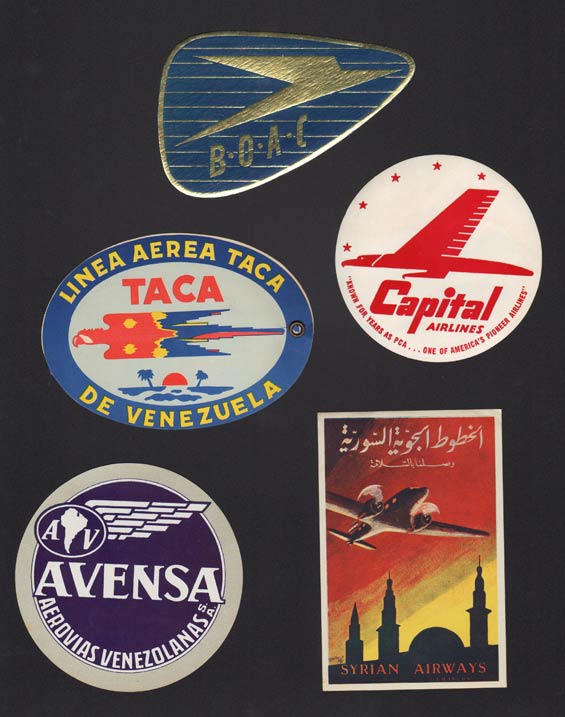 |
Airline Baggage Stickers, Dates Unknown (Source: Baldwin Family)
 |
Next, three panels of hotel labels.
Hotel Baggage Labels, Dates Unknown (Source: Baldwin Family)
 |
It is not clear if Baldwin was a guest in all these hotels.
Hotel Baggage Labels, Dates Unknown (Source: Baldwin Family)
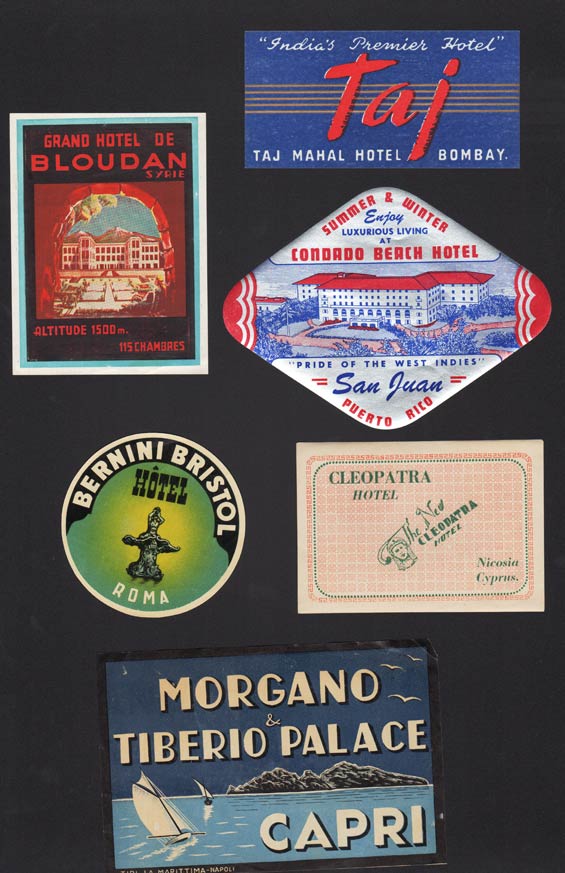 |
Hotel Baggage Labels, Dates Unknown (Source: Baldwin Family)
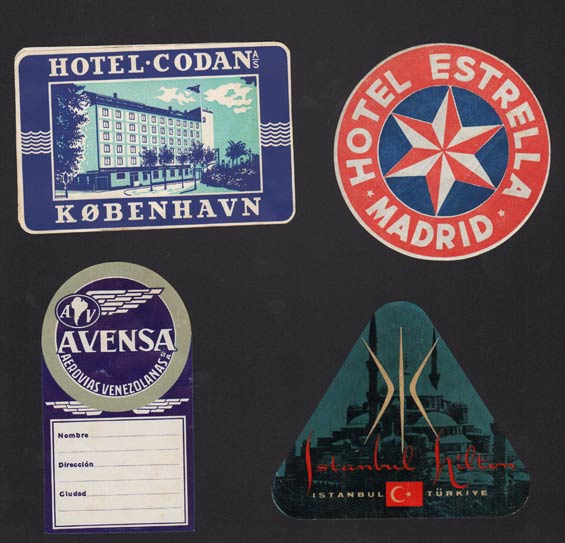 |
---o0o---
MOVIE
This video is a 32-minute semi-documentary of Colonel Baldwin's life as well as his experiences in North Africa, Italy, England, France and Germany during of WWII. The creator of the photomongage and editor of the film was Baldwin's son, cited in the right sidebar. The movie includes pilot Baldwin's voice in an interview related to "Operation Varsity" near the end of the film.
Besides a photomontage, some scenes you will see are transport C-47s and B-26s in formation flight, views of aircraft nose art, aerial flights over Africa, Italy, and Germany, native markets (Tunisia?), castles, transport gliders, Licata Airfield on Sicily (look for the P-38 on the ground), a party in Rome (officers standing around drinking), gathering of Arabs on horseback reviewed by Charles DeGaulle, Baldwin and other officers on camel back at the Pyramids in Egypt, an English garden at Eastcote, the Normandy beachhead sometime after the D-Day invasion, gliders on the ground in a D-Day landing area, and views of his experience during the last paratroop assault across the Rhine River during "Operation Varsity," March 24, 1945.
Please note, the movie is small in format. Please use right click and "zoom in" to enlarge the image on your screen. Invoke the MOVIE HERE and choose Baldwin_Movie from the menu.
---o0o---
PILOT LOG BOOKS
Baldwin's six pilot log books are meticulously kept in a neat handwriting; some of the neatest on dmairfield.org. Compare them with others found at Register pilots John Livingston, Elmer McLeod and Frederick Trapnell. There are six books, two are military, one keeps track of United Air Lines training activities, and two books log his scheduled flights with United. Five images accompany the six PDF downloads.
I have entered a few highlights of interest regarding each log. Because of his completeness, if you're a fan or historian of the early United Air Lines, their schedules and their airplanes (especially the numerous Boeing 247 and Douglas DC-3 registrations he logged) then Baldwin's later books are good sources of information on the names and itineraries of the early pilots, the flight attendants and the hardware they flew. If you find anything else of interest that I have missed, especially as it might relate to the Davis-Monthan Airfield Register, please let me KNOW.
His logs cover almost a decade, 1933-1942. His flights during WWII and beyond, if they were logged, are lost to us. The logs we do have include two military logs and four United Airlines logs.The table below is your entry to each book. Or click the individual section links to open them.
Number |
Dates |
Download Size |
Source |
1 |
|
11Mb |
Military |
2 |
|
3Mb |
Military |
3 |
|
3Mb |
UAL (training) |
4 |
|
12Mb |
UAL |
5 |
|
16Mb |
UAL |
6 |
|
3Mb |
UAL |
Log Number 1, July 6, 1933 to August 28, 1935: The data page in this log (PDF page 3) is signed by Register pilot Lester Maitland as Operations Officer, Kelly Field. Most of his hours in this log were spent in the large twin-engined bombers common in the Army stable during the late 1920s and early 1930s.
His only landing at Tucson, Thursday September 27, 1934, is documented on PDF page 43 of this log. An interesting finding in the entry is that he was leading a flight of three, with the other two pilots named Lt. Noyes and Captain Hamilton. Curiously, neither Noyes nor Hamilton signed the Register. Rather another Martin YB-12-A bomber flown by Cadet George A. Secor is signed on the line following Baldwin. Secor carried three passengers, one of whom could have been Noyes or Hamilton. A third Martin bomber was not signed in the Register.
Below, an official Army photograph of a Martin B-6A found in Baldwin's albums. Although indicative of early Martin types, the B-6 is not among the models cited as flown by Baldwin in either this log or the next one.
Martin B-6A, December 10, 1936 (Source: Baldwin Family)
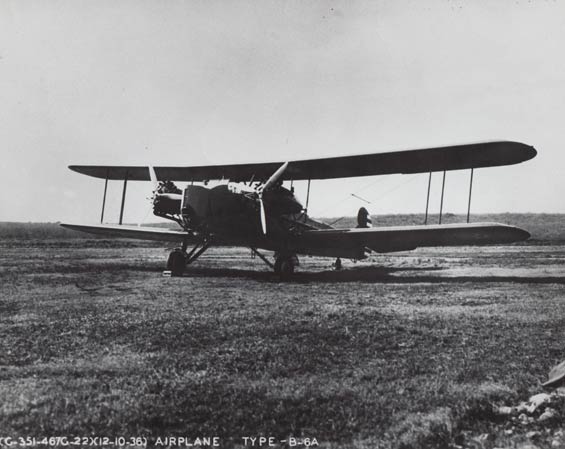 |
On April 11, 1935, this log shows he took his wife of five months, Gail, up for a ride in a YB-12-A. They flew for 30 minutes. On June 24, 1935 (PDF page 53) he logged 50 minutes in a B-12A for the purpose of flying, "... to Oakland & return to see U.A. Lines." This might have been an early recruitment visit for him, since he started employment with UAL April, 1936. During August, 1935 he flew twice as copilot with "Lt. Col. Tinker," Register pilot Clarence Tinker. This log contains as a foldout his grade summary, dated October 15, 1933, for the training courses taken as a cadet.
The North American BT-9 (Source: Aircraft Yearbook, 1939)
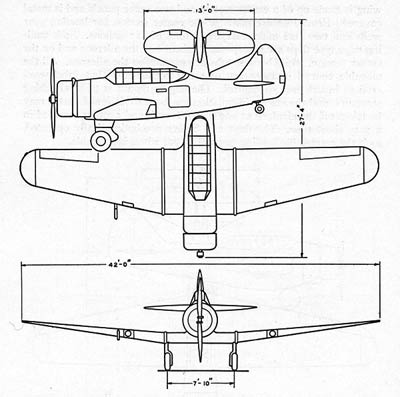 |
Log Number 2, September 3, 1935 to January 15, 1940: This book has Baldwin based at Hamilton Field, CA from December 4, 1934 to October 15, 1935, at Long Beach, CA from November 5, 1935 to April 12, 1936, and then to Chicago on April 12, 1936. He lived in Ventura, CA with his wife.
Most of his flying at Hamilton Field was done in PT-3 and B-12 aircraft. This continued when he moved to Long Beach, with many of the flights being identified as "local" to airports in the greater Los Angeles area (Clover Field, Mines, Culver City, March, etc.). On April 11, 1936 he logged 40 minutes carrying his mother in an unidentified Kinner aircraft over the Grand Central Air Terminal at Glendale, CA.
The last three pages of Log Number 2 cover 1938-40 and log flights that were probably made during his Army Air Corps Reserve duty. Most of those flights were in variants of the then relatively new BT-9, shown at left from this REFERENCE, volume 1939. The original BT-9 was a fixed-gear airplane. Later variants had retractable landing gear.
During November, 1938 (PDF page 12) he flew two large loops around the U.S. With a BT-9C, departing on November 20th from Chicago, he flew to Indianapolis and then Cincinnati, OH. He remained in Cincinnati overnight and probably enjoyed the new terminal building there that had been built two years earlier.
On the 21st he left Cincinnati and flew to Louisville, Nashville, Memphis and Little Rock, AR. On the 22nd from Little Rock to Barksdale, LA, Hensley (Dallas, TX) Tulsa and Muskogee, OK (Hatbox). On the 23rd from Muskogee to Wichita and Ft. Riley, KS. On the 24th from Ft. Riley to Kansas City, Quincy, IL and back to Chicago on the 24th. He spent 20.05 hours in the air over four days.
On the 25th he got back in the air from Chicago to Pittsburgh, PA and to Washington, DC (Bolling Field). On the 26th he flew from Bolling to Musten Field at Philadelphia, PA. He spent a day at Philadelphia and departed on the 28th for Bolling again, then Charleston, WV, Cincinnati and back to Chicago. Total time in the air was 13.4 hours over three days of flying. This was an energetic itinerary for his BT-9 trainer. No reason was given in his log for these flights.
By the end of this log, Baldwin had accumulated 857.15 flight hours, 32.35 of which were a night. He also logged 252.55 hours as an observer, for a total of over 1,000 hours in the air.
Log Number 3, May 11, 1935 to November 5, 1942: This book is special in that it logs mostly his training and other employment data with United Air Lines. The entries comprise Link simulator sessions, radio "range" practice, transition training and navigation problems, some of which were done on scheduled UAL trips.
PDF page 15 documents on January 27, 1940 Baldwin's "Final hood check and air work for promotion to Capt." About a month later, big day was February 24, 1940. On this date he flew the Douglas DC-3 NC16072 on scheduled trip 14 for the company. He noted in his log, "First check out ride enroute as Captain." A photograph of NC16072 is on the Web at the link, courtesy of the San Diego Aerospace Museum photo stream. This airplane was destroyed just under a year later, on January 12, 1941 in a fire (at least one Web source says a collision) in Salt Lake City, UT.
The front identification pages of this log provide a summary of Baldwin's training and certification acquisitions (PDF page 4). That page is shown below. Another page documents his completion dates for UAL employment forms.
Training Summary From UAL Training Log, May 11, 1935 to November 5, 1942 (Source: Baldwin Family)
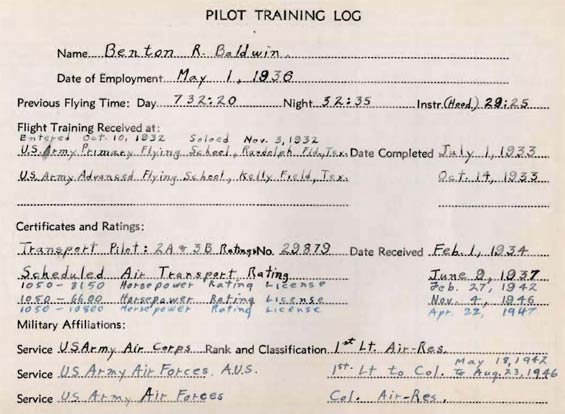 |
On the page above, he added some of his military information after the fact, because the dates are after the inclusive dates of this log. The final four pages of this log are foldouts that include some of his training notes and a log of what appear to be passenger flights.
Log Number 4, April 29, 1936 to June 18, 1937: This book records Baldwin's first flights as second officer with UAL. He flew right seat in the Boeing 247, a workhorse of scheduled air transport before the Douglas DC-3 was widely introduced. As usual, he lists his flight itineraries, aircraft registration numbers and in the remarks he cites the names of his pilots and flight attendants. Based at Cheyenne, WY, the majority of flights are to and from Cheyenne, Des Moines, Omaha, North Platte, Chicago, Salt Lake and a few other midwest and western destinations.
His first flight as a UAL copilot or second officer was recorded on May 3rd, from Cheyenne, WY to Lincoln, NB on PDF page 2. His pilot was P. Munson. He logged 2.27 flight hours, 1.14 of which was at night, over 369 miles. Everybody has to start somewhere. On the same page, he flew as copilot twice with fellow Register pilot Elrey Jeppesen. Baldwin noted in his log, "I flew blind some." Interestingly, his first landing was recorded on May 18th. His pilot "Mitchell," threw him that bone. Beginning in July, he logs more landings and takeoffs, and instrument flight, receiving more and more responsibility from his pilots in command.
PDF page 20 is of particular interest, because Baldwin cites as his pilots "Jack Knight" and "Yager" (sic).These men are probably James H. "Jack" Knight (1892-1945) and Frank Yeager (neither Register pilots), who, back in the 1920s, had been heroes of the airmail. More detailed information about Knight is at this link. Now working for UAL, Baldwin flew frequently with Knight and Yeager on into the fall of 1936. Jeppesen, Knight, Yeager? Clearly, if you were going to excel at your craft, as a second officer these were THE guys to learn from.
His first flight in a Douglas DC-3 was recorded on February 12, 1937 from Chicago to Omaha, NB. The airplane was NC16061 (not a Register airplane); his pilot was P.E. Reeder. On April 3-4, Baldwin flew two 45-minute check rides in the Boeing 40B NC292 (not a Register airplane). He flew that airplane another half dozen times over the next month.
His summary at the end of this log (PDF page 53) shows he accumulated 526 hours and 27 minutes of flight time with United Air Lines, flew 158,425 miles and carried 4,464 passengers.
Log Number 5, June 21, 1937 to October 29, 1941: With log #5, Baldwin moves to New Jersey. He also transitions in June, 1937 from the Boeing 247 to the Douglas DC-3. Over the first few months of this log, the Douglas replaces the Boeing almost completely in Baldwin's flights. This book documents numerous license renewals and instrument flight checks.
One of his flights carried the Mayor of Passaic, NY, from whom Baldwin received a thank you letter, below, on October 2, 1938. This flight is logged on PDF page 19 on the top line. They flew on October 1st for 35 minutes in the Douglas DC-3-21, NC18939 (not a Register airplane). Baldwin identified their flight as, "Courtesy (Mayor)."
Letter From Mayor of Passaic, NJ, October 2, 1938 (Source: Baldwin Family)
 |
This interesting letter, from a gentleman with 19th century roots, gives a sense of what it was like to have one's very first flight, even 35 years after the Wright brothers first made theirs.
Across the Hudson River the following year Mayor Fiorello La Guardia hosted the renaming of Glenn H. Curtiss Airport to North Beach Airport, the airport that would ultimately be named after him. Below, an invitation from the Mayor to that event, and pink parking permit.
Invitation to Opening of What Was to Become LaGuardia Field, October 15, 1939 (Source: Baldwin Family)
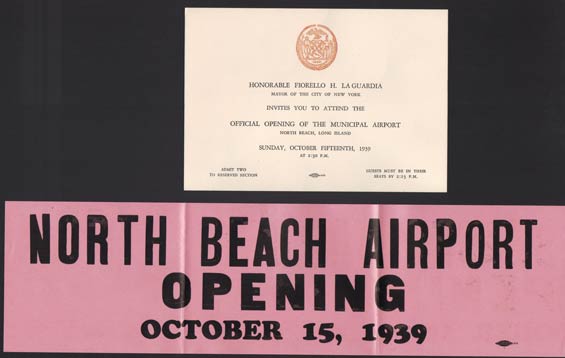 |
One flight on February 28, 1940 (PDF page 35) cites, "2 hops for television" in a Boeing 247. If anyone knows anything about these flights, please let me KNOW. By the end of this log, he had accumulated 3,104 hours and 15 inutes of airline flight time, including 261:45 instrument hours. He did not keep track of miles or passenger numbers.
Log Number 6, November 16, 1941 to May 11, 1942: With log #6, we find Baldwin posted at La Guardia Field, NY. Interestingly, Pearl Harbor Day, December 7, 1941 came and went in his log with no comment by him. He did fly that day from Chicago to La Guardia in the DC-3 DSTA NC25620 (not a Register airplane). Scheduled flights appeared to go on uninterrupted through the rest of his book as WWII spooled up. On February 20, 1942 he did note that he flew "5 Marine pilots." This log ends abruptly on May 11, 1942 with 30 minutes flown in a UAL Link trainer. He had accumulated 5,878 hours and 44 minutes of flight time.
---o0o---
RETIREMENT
"Lucky" Baldwin retired from the Air Force December 17, 1964 via an order signed by U.S. Chief of Staff, Curtis LeMay, dated November 25, 1964. That order is below. His length of service, including 11 years and 11 months of Reserve duty, was 32 years seven months and three days.
Retirement Order, November 24, 1964 (Source: Baldwin Family)
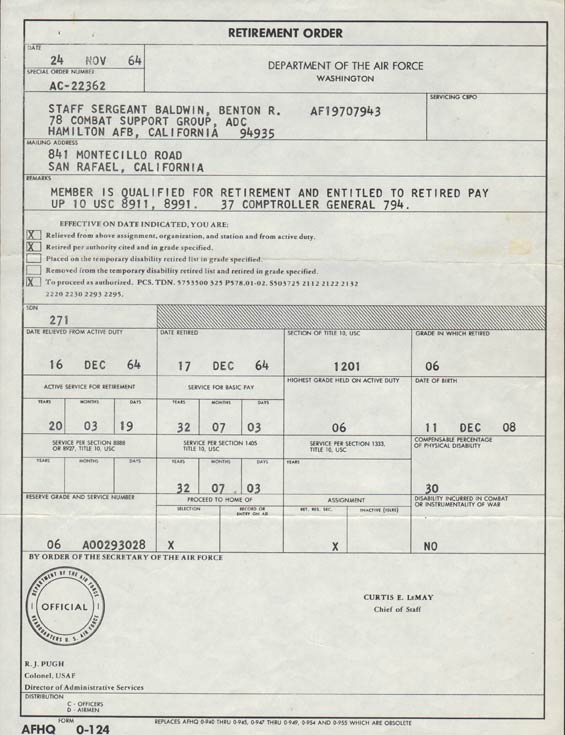 |
He received also the following Certificate of Retirement presented by the Air Defense Command, which cites his WWII accomplishments as well as lists his medals and citations.
Retirement Certificate, December 17, 1964 (Source: Baldwin Family)
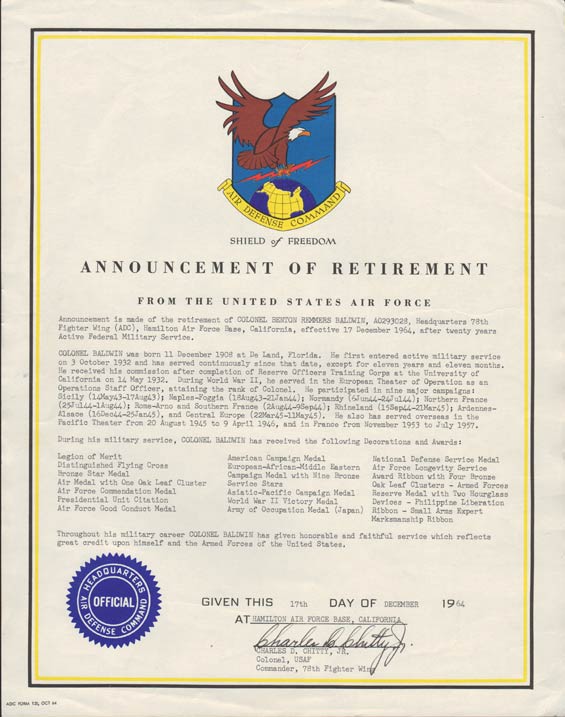 |
And this two-page press release from Hamilton Air Force Base, Joint Office of Information announced his retirement to the media.
Hamilton Air Force Base Press Release, December 18, 1964, Page 1 (Source: Baldwin Family)
 |
Hamilton Air Force Base Press Release, December 18, 1964, Page 2 (Source: Baldwin Family)
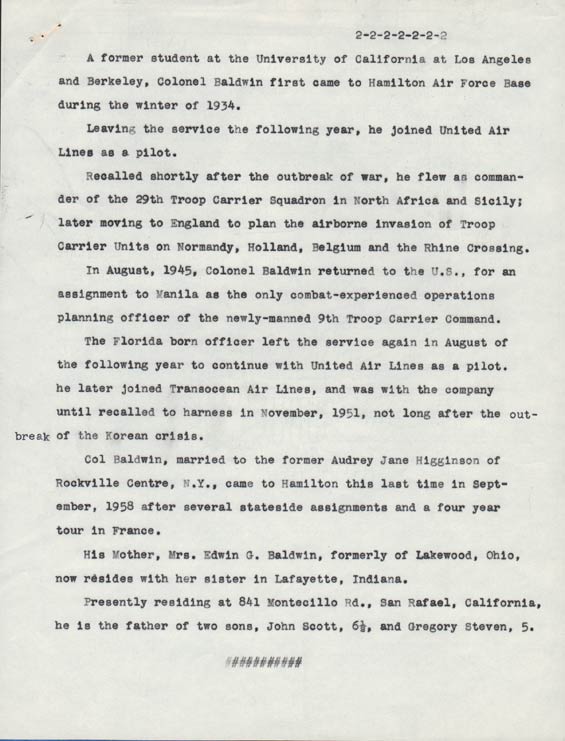 |
B.R. Baldwin, September 1994 (Source: Baldwin Family)
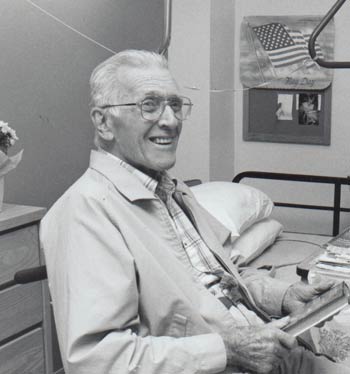 |
By his own description, Benton Baldwin was a highly personable individual. He described himself in his informal autobiography as, "Resourceful, thoroughly responsible, flexible and cooperative, learn new things easily, highly observant, and a terrifically hard worker with drive."
He writes about doing a lot of public speaking for the military and for United Air Lines at clubs, organizations and schools. He was often chosen by the publicity department of UAL to participate in airport dedications, courtesy flights for important people (see the Mayor of Passaic, NY, above) and promotion projects tied in with other companies (raincoats, above, cigarettes, etc.).
He retired from the military in 1964. The December 18, 1964 press release from Hamilton Air Force Base displayed above announced his retirement.
At left, a photograph of Baldwin during September, 1994, about nine months before he passed away. He appears to be in a hospital room. Below, Baldwin's obituary from an unknown source. He lived 86 years and, from his world-wide travel perspectives and WWII responsibilities, enjoyed an adventurous life and a long retirement.
B.R. Baldwin, Obituary, 1995 (Source: Baldwin Family)
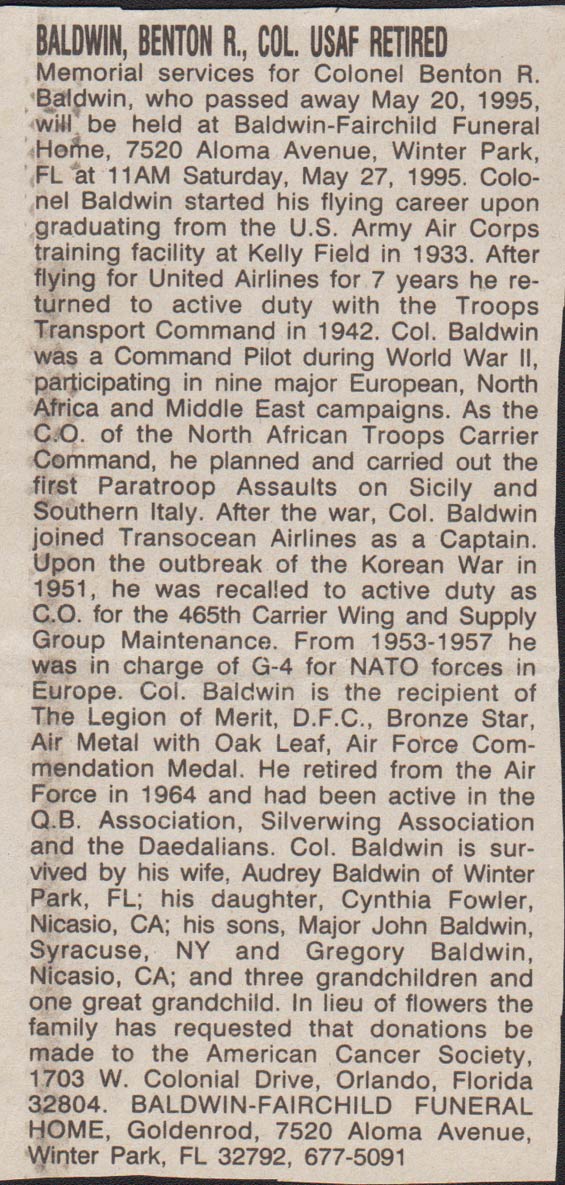 |
---o0o---
Dossier 2.2.21
THIS PAGE UPLOADED: 07/17/12 REVISED: 01/21/16, 01/06/23
|

